Study of Selected Physical-Mechanical Properties of Corn Grains Important from the Point of View of Mechanical Processing Systems Designing
Abstract
1. Introduction
2. Materials and Methods
2.1. Sample Preparation
2.2. Research Methods
2.2.1. The Measurement of the Physical Properties
- Volume-equivalent sphere diameter DE, that is, diameter of a sphere of the same volume VT as the tested grain [68]:
- Sphericity index f, which defines the ratio of the grain volume to the volume described on the grain sphere with a diameter equal to the grain length a1 [69]:f = (a1·a2·a3)1/3/a1
- Geometric volume Vg, which corresponds to the volume of an ellipsoid with dimensions a1, a2, and a3 [64]:Vg = π·a1·a2·a3/6
2.2.2. Determination of Mechanical Properties
2.2.3. Point of Inflection, Bioyield Point, and Rupture (Fracture) Energy
2.3. Analytical Methods
3. Results and Discussion
3.1. Physical Properties of Corn Grains
3.2. Strength Properties and Fracture Energy
3.3. Grain Size Effect
3.4. Limitations and Advantages
4. Conclusions
Funding
Institutional Review Board Statement
Informed Consent Statement
Data Availability Statement
Conflicts of Interest
Appendix A
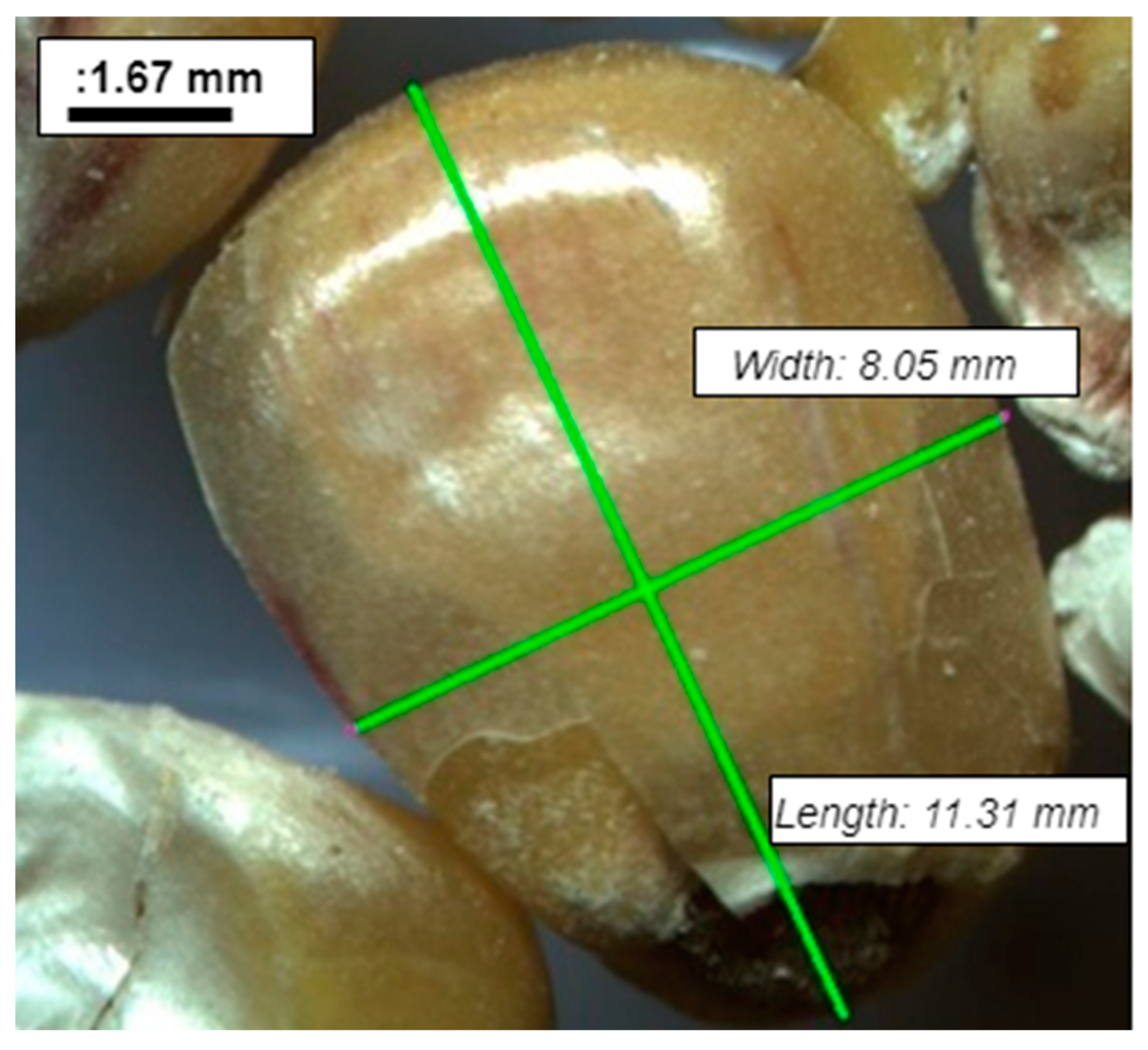
| Parameter | Distribution | |||||
|---|---|---|---|---|---|---|
| Lognormal | Weibull | Gamma | ||||
| µ | σ | α | β | α | σ | |
| FPI [N] | - | - | 109.1439 | 0.89281 | - | - |
| FBP [N] | - | - | 253.61107 | 1.16228 | - | - |
| FRP [N] | - | - | 627.11731 | 2.06287 | 3.64698 | 151.85166 |
| EmPI [J/kg] | 2.17009 | 1.54562 | 18.73184 | 0.71195 | - | - |
| EmBP [J/kg] | 3.82259 | 1.23579 | 84.44912 | 0.85467 | 0.83563 | 110.87089 |
| EmRP [J/kg] | 5.91986 | 0.71669 | 531.83095 | 1.48228 | 2.16927 | 219.93337 |
| SPI [Pa] | 16.5451 | 0.8459 | 2.3033 × 107 | 1.33441 | - | - |
| SBP [Pa] | 16.83799 | 0.71216 | 2.91069 × 107 | 1.5688 | - | - |
| SRP [Pa] | 16.99646 | 0.58967 | 3.19944 × 107 | 1.92147 | 3.27416 | 8,630,478.29 |
| E [Pa] | 17.90752 | 0.73007 | 8.39823 × 107 | 1.61551 | 2.3764 | 3.15428 × 107 |
| Stiffness [Pa] | 17.94835 | 0.73007 | 8.74816 × 107 | 1.61551 | 2.3764 | 3.28571 × 107 |
| Parameter | R2 of Distributions | ||
|---|---|---|---|
| Lognormal | Weibull | Gamma | |
| FPI [N] | - | 0.979 | - |
| FBP [N] | - | 0.994 | - |
| FRP [N] | - | 0.995 | 0.993 |
| EmPI [J/kg] | 0.987 | 0.982 | - |
| EmBP [J/kg] | 0.992 | 0.994 | 0.995 |
| EmRP [J/kg] | 0.9955 | 0.9958 | 0.996 |
| SPI [Pa] | 0.992 | 0.987 | - |
| SBP [Pa] | 0.993 | 0.991 | - |
| SRP [Pa] | 0.9959 | 0.9956 | 0.9958 |
| E [Pa] | 0.998 | 0.995 | 0.997 |
| Stiffness [Pa] | 0.998 | 0.995 | 0.997 |
| Weibull fitting | 4.0–4.5 mm | 4.5–5.0 mm | 5.0–5.5 mm | >5.5 mm | |
 | y0 | –30.54 ± 23.64 | −15.92 ± 6.35 | −4.21 ± 6.76 | −4.44 ± 14.44 |
| A1 | 222.15 ± 193.17 | 106.44 ± 7.4 | 96.81 ± 9.45 | 91.08 ± 16.39 | |
| a | 777.77 ± 2433.01 | 53.85 ± 4.37 | 78.06 ± 10.09 | 33.61 ± 4.10 | |
| b | 0.37 ± 0.19 | 0.87 ± 0.10 | 0.99 ± 0.18 | 1.91 ± 0.76 | |
| µ | 3218.20 ± 15,088.27 | 57.59 ± 4.76 | 78.51 ± 12.82 | 29.82 ± 3.60 | |
| σ | 11,482.90 ± 64,018.93 | 66.03 ± 11.30 | 79.55 ± 24.71 | 16.26 ± 6.10 | |
| R2 | 0.988 | 0.975 | 0.958 | 0.956 | |
| Weibull fitting | 4.0–4.5 mm | 4.5–5.0 mm | 5.0–5.5 mm | >5.5 mm | |
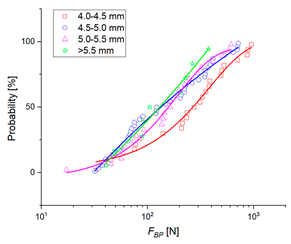 | y0 | 3.33 ± 3.95 | −1884.40 ± 22,431.29 | −5.35 ± 4.69 | −238.77 ± 8193.17 |
| A1 | 97.18 ± 8.91 | 2072.44 ± 22,682.30 | 100.75 ± 6.65 | 3151.18 ± 1,590,007.82 | |
| a | 380.59 ± 33.86 | 7.73 × 10−4 ± 0.08 | 189.18 ± 10.25 | 1.80 × 109 ± 7.89 × 1012 | |
| b | 1.19 ± 0.18 | 0.083 ± 0.43 | 1.22 ± 0.14 | 0.14 ± 7.54 | |
| µ | 358.67 ± 42.16 | 476,075.22 ± 2.69 × 107 | 177.19 ± 10.73 | 9.47 × 1012 ± 4.86 × 1016 | |
| σ | 302.24 ± 75.02 | 8.37 × 108 ± 8.28 × 1010 | 145.91 ± 21.34 | 5.63 × 1014 ± 3.02 × 1018 | |
| R 2 | 0.986 | 0.990 | 0.989 | 0.971 | |
| Weibull fitting | 4.0–4.5 mm | 4.5–5.0 mm | 5.0–5.5 mm | >5.5 mm | |
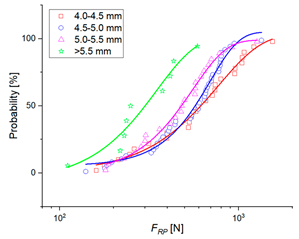 | y0 | 0.08 ± 3.30 | 5.26 ± 2.15 | −0.77 ± 3.71 | −6.38 ± 22.08 |
| A1 | 102.84 ± 7.15 | 99.72 ± 4.84 | 99.75 ± 5.39 | 107.79 ± 40.40 | |
| a | 771.20 ± 35.71 | 692.45 ± 18.83 | 554.65 ± 15.02 | 349.56 ± 74.61 | |
| b | 1.79 ± 0.19 | 2.68 ± 0.20 | 2.30 ± 0.22 | 1.96 ± 1.03 | |
| µ | 686.07 ± 33.80 | 615.64 ± 16.27 | 491.37 ± 13.36 | 309.92 ± 67.81 | |
| σ | 397.05 ± 51.55 | 247.44 ± 19.18 | 226.48 ± 19.94 | 165.14 ± 100.06 | |
| R 2 | 0.991 | 0.983 | 0.990 | 0.941 | |
| Gamma fitting | 4.0–4.5 mm | 4.5–5.0 mm | 5.0–5.5 mm | >5.5 mm | |
 | y0 | −46.42 ± 32.56 | −22.10 ± 9.63 | −8.06 ± 6.87 | 4.87 ± 4.71 |
| A1 | 657.19 ± 605,661.04 | 112.84 ± 10.37 | 104.16 ± 9.28 | 83.63 ± 5.88 | |
| a | 0.18 ± 0.08 | 0.48 ± 0.10 | 0.63 ± 0.14 | 6.50 ± 2.07 | |
| b | 1,282,758.94 ± 6.68 × 109 | 19.70 ± 4.28 | 22.07 ± 6.79 | 0.61 ± 0.20 | |
| µ | 227,235.93 ± 1.18 × 109 | 9.52 ± 0.74 | 13.96 ± 2.06 | 3.98 ± 0.19 | |
| σ | 539,897.14 ± 2.81 × 109 | 13.69 ± 1.70 | 17.55 ± 3.79 | 1.56 ± 0.27 | |
| R 2 | 0.982 | 0.983 | 0.979 | 0.984 | |
| Gamma fitting | 4.0–4.5 mm | 4.5–5.0 mm | 5.0–5.5 mm | >5.5 mm | |
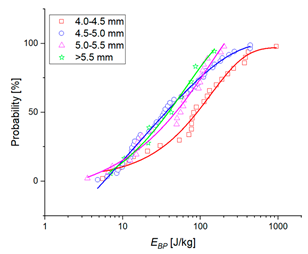 | y0 | 2.10 ± 4.44 | −498.77 ± 697.04 | −14.30 ± 18.17 | −24.87 ± 45.03 |
| A1 | 95.01 ± 6.68 | 599.65 ± 699.21 | 146.31 ± 55.33 | 138.26 ± 70.04 | |
| a | 0.89 ± 0.19 | 0.06 ± 0.07 | 0.53 ± 0.25 | 0.55 ± 0.51 | |
| b | 152.22 ± 42.16 | 270.98 ± 92.32 | 254.23 ± 305.36 | 120.87 ± 165.61 | |
| µ | 135.74 ± 13.18 | 14.95 ± 15.18 | 133.94 ± 102.15 | 66.10 ± 35.26 | |
| σ | 143.74 ± 25.64 | 63.64 ± 23.59 | 184.53 ± 180.33 | 89.38 ± 83.06 | |
| R 2 | 0.984 | 0.99201 | 0.976 | 0.986 | |
| Gamma fitting | 4.0–4.5 mm | 4.5–5.0 mm | 5.0–5.5 mm | >5.5 mm | |
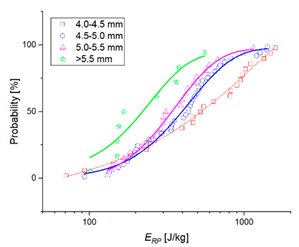 | y0 | −16.86 ± 10.24 | 0.003 ± 3.28 | −3.80 ± 5.29 | 5.56 ± 0 |
| A1 | 154.87 ± 34.96 | 97.75 ± 4.30 | 100.96 ± 6.69 | 88.85 ± 14.91 | |
| a | 0.70 ± 0.20 | 2.67 ± 0.39 | 2.95 ± 0.61 | 3.27 ± 1.81 | |
| b | 1684.99 ± 1089.80 | 166.08 ± 24.23 | 123.39 ± 24.87 | 74.91 ± 56.93 | |
| µ | 1177.84 ± 445.69 | 442.98 ± 11.78 | 364.45 ± 12.41 | 244.86 ± 57.38 | |
| σ | 1408.78 ± 718.86 | 271.23 ± 20.47 | 212.06 ± 21.49 | 135.43 ± 66.26 | |
| R 2 | 0.993 | 0.988 | 0.991 | 0.912 | |
| Lognormal fitting | 4.0–4.5 mm | 4.5–5.0 mm | 5.0–5.5 mm | >5.5 mm | |
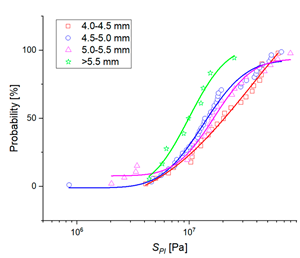 | y0 | −14.48 ± 12.26 | −1.06 ± 2.56 | 7.80 ± 2.01 | −1.80 ± 15.32 |
| A | 178.37 ± 66.38 | 93.80 ± 3.63 | 85.79 ± 3.50 | 104.40 ± 24.32 | |
| xc | 17.40 ± 0.52 | 16.41 ± 0.03 | 16.62 ± 0.04 | 16.11 ± 0.12 | |
| w | 1.60 ± 0.55 | 0.68 ± 0.05 | 0.62 ± 0.06 | 0.61 ± 0.21 | |
| µ | 1.31 × 108 ± 1.83 × 108 | 1.69 × 107 ± 687,179.05 | 2.01 × 107 ± 1,228,354.58 | 1.19 × 107 ± 1,666,522.57 | |
| σ | 4.56 × 108 ± 1.07 × 109 | 1.30 × 107 ± 1,577,012.61 | 1.38 × 107 ± 2,290,183.04 | 8,001,674.74 ± 4,164,865.25 | |
| R2 | 0.991 | 0.988 | 0.985 | 0.982 | |
| Lognormal fitting | 4.0–4.5 mm | 4.5–5.0 mm | 5.0–5.5 mm | >5.5 mm | |
 | y0 | −17.44 ± 35.46 | −21.7 ± 11.14 | 5.57 ± 2.26 | −8.10 ± 17.38 |
| A | 1137.62 ± 7596.58 | 132.59 ± 18.83 | 87.68 ± 3.58 | 118.46 ± 32.16 | |
| xc | 21.43 ± 16.33 | 16.64 ± 0.08 | 16.84 ± 0.03 | 16.46 ± 0.09 | |
| w | 2.70 ± 5.12 | 1.14 ± 0.20 | 0.51 ± 0.05 | 0.58 ± 0.21 | |
| µ | 7.65 × 1010 ± 2.30 × 1012 | 3.21 × 107 ± 6,842,766.15 | 2.35 × 107 ± 1,001,842.68 | 1.66 × 107 ± 2,468,284.52 | |
| σ | 2.89 × 1012 ± 1.27 × 1014 | 5.22 × 107 ± 2.72 × 107 | 1.30 × 107 ± 1,763,464.72 | 1.04 × 107 ± 5,738,377.74 | |
| R 2 | 0.984 | 0.990 | 0.986 | 0.989 | |
| Lognormal fitting | 4.0–4.5 mm | 4.5–5.0 mm | 5.0–5.5 mm | >5.5 mm | |
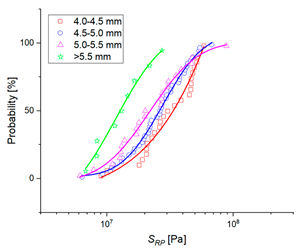 | y0 | −10.90 ± 22.68 | 1.52 ± 1.29 | −2.03 ± 4.01 | −20.51 ± 49.56 |
| A | 1399.77 ± 11,973.53 | 105.08 ± 3.30 | 102.94 ± 6.57 | 129.95 ± 73.33 | |
| xc | 20.65 ± 14.10 | 17.13 ± 0.02 | 16.90 ± 0.045 | 16.28 ± 0.23 | |
| w | 1.94 ± 3.84 | 0.58 ± 0.03 | 0.69 ± 0.069 | 0.70 ± 0.48 | |
| µ | 6.15 × 109 ± 1.32 × 1011 | 3.27 × 107 ± 974,810.58 | 2.78 × 107 ± 1,791,511.93 | 1.51 × 107 ± 3,316,183.17 | |
| σ | 4.01 × 1010 ± 1.17 × 1012 | 2.08 × 107 ± 1,712,189.50 | 2.18 × 107 ± 3,850,342.57 | 1.20 × 107 ± 1.26 × 107 | |
| R2 | 0.972 | 0.997 | 0.989 | 0.985 |
References
- Kovács, Á.; Kerényi, G. Physical Characteristics and Mechanical Behaviour of Maize Stalks for Machine Development. Int. Agrophysics 2019, 33, 427–436. [Google Scholar] [CrossRef]
- Wiercioch, M.; Niemiec, A.; Roma, L. The impact of wheat seeds size on energy consumption of their grinding process. Inzynieria Rol. 2008, 103, 367–372. [Google Scholar]
- Werechowska, M. Some Physical Properties of Cereal Grain and Energy Consumption of Grinding. Agric. Eng. 2014, 239–249. [Google Scholar] [CrossRef]
- Dziki, D.; Laskowski, J. Influence of Wheat Kernel Geometrical Properties on the Mechanical Properties and Grinding Ability. Acta Agrophys. 2003, 2, 735–742. [Google Scholar]
- Kruszelnicka, W.; Bałdowska-Witos, P.; Kasner, R.; Flizikowski, J.; Tomporowski, A.; Rudnicki, J. Evaluation of Emissivity and Environmental Safety of Biomass Grinders Drive. Przem. Chem. 2019, 98, 1494–1498. [Google Scholar]
- Atashbar, N.Z.; Labadie, N.; Prins, C. Modelling and Optimisation of Biomass Supply Chains: A Review. Int. J. Prod. Res. 2018, 56, 3482–3506. [Google Scholar] [CrossRef]
- Jewiarz, M.; Wróbel, M.; Mudryk, K.; Szufa, S. Impact of the Drying Temperature and Grinding Technique on Biomass Grindability. Energies 2020, 13, 3392. [Google Scholar] [CrossRef]
- Bembenek, M. Exploring Efficiencies: Examining the Possibility of Decreasing the Size of the Briquettes Used as the Batch in the Electric Arc Furnace Dust Processing Line. Sustainability 2020, 12, 6393. [Google Scholar] [CrossRef]
- Hryniewicz, M.; Bembenek, M.; Janewicz, A.; Kosturkiewicz, B. Brykietowanie materiałów drobnoziarnistych w prasach walcowych z niesymetrycznym układem zagęszczania. Przem. Chem. 2015, 94, 2223–2226. [Google Scholar] [CrossRef]
- Iqbal, Y.; Lewandowski, I.; Weinreich, A.; Wippel, B.; Pforte, B.; Hadai, O.; Tryboi, O.; Spöttle, M.; Peters, D. Maximising the Yield of Biomass from Residues of Agricultural Crops and Biomass from Forestry; ECOFYS: Berlin, Germany, 2016. [Google Scholar]
- Chhabra, N.; Kaur, A. Studies on Physical and Engineering Characteristics of Maize, Pearl Millet and Soybean. J. Pharmacogn. Phytochem. 2017, 6, 1–5. [Google Scholar]
- Kruszelnicka, W. Study of Physical Properties of Rice and Corn Used for Energy Purposes. In Proceedings of the Renewable Energy Sources: Engineering, Technology, Innovation, Krynica, Poland, 20–22 June 2020; Wróbel, M., Jewiarz, M., Szlęk, A., Eds.; Springer International Publishing: Berlin/Heidelberg, Germany, 2020; pp. 149–162. [Google Scholar]
- Chel-Guerrero, L.; Parra-Pérez, J.; Betancur-Ancona, D.; Castellanos-Ruelas, A.; Solorza-Feria, J. Chemical, Rheological and Mechanical Evaluation of Maize Dough and Tortillas in Blends with Cassava and Malanga Flour. J. Food Sci. Technol. 2015, 52, 4387–4395. [Google Scholar] [CrossRef]
- Li, Y.; Qin, T.; Chen, J.; Zhao, Z. Experiments and Analysis on Mechanical Property of Corn Stalk Reciprocating Cutting. Trans. Chin. Soc. Agric. Eng. 2011, 27, 160–164. [Google Scholar]
- Moya, M.; Aguado, P.J.; Ayuga, F. Mechanical Properties of Some Granular Agricultural Materials Used in Silo Design. Int. Agrophysics 2013, 27, 181–193. [Google Scholar] [CrossRef]
- Flizikowski, J.B.; Kruszelnicka, W.; Tomporowski, A.; Mrozinski, A. A Study of Operating Parameters of a Roller Mill with a New Design. AIP Conf. Proc. 2019, 2077, 020018. [Google Scholar] [CrossRef]
- Kowalczyk-Jusko, A.; Kowalczuk, J.; Szmigielski, M.; Marczuk, A.; Jozwiakowski, K.; Zarajczyk, K.; Maslowski, A.; Slaska-Grzywna, B.; Sagan, A.; Zarajczyk, J. Quality of biomass pellets used as fuel or raw material for syngas production. Przemy. Chem. 2015, 94, 1835–1837. [Google Scholar]
- Zając, G.; Węgrzyn, A. Analysis of Work Parameters Changes of Diesel Engine Powered with Diesel Fuel and Faee Blends. Eksploat. Niezawodn.-Maint. Reliab. 2008, 2, 17–24. [Google Scholar]
- Tomporowski, A.; Flizikowski, J.; Kruszelnicka, W. A new concept of roller-plate mills. Przem. Chem. 2017, 96, 1750–1755. [Google Scholar] [CrossRef]
- Dabbour, M.I.; Bahnasawy, A.; Ali, S.; El-Haddad, Z. Grinding Parameters and Their Effects on the Quality of Corn for Feed Processing. J. Food Process. Technol. 2015, 06, 482. [Google Scholar] [CrossRef]
- Kaczmarczyk, J.; Grajcar, A. Numerical Simulation and Experimental Investigation of Cold-Rolled Steel Cutting. Mater. Basel Switz. 2018, 11, 1263. [Google Scholar] [CrossRef]
- Kaczmarczyk, J. Modelling of Guillotine Cutting of a Cold-Rolled Steel Sheet. Materials 2019, 12, 2954. [Google Scholar] [CrossRef]
- Tomporowski, A.; Flizikowski, J.; Wełnowski, J.; Najzarek, Z.; Topoliński, T.; Kruszelnicka, W.; Piasecka, I.; Śmigiel, S. Regeneration of Rubber Waste Using an Intelligent Grinding System. Przem. Chem. 2018, 97, 1659–1665. [Google Scholar] [CrossRef]
- Mannheim, V. Empirical and Scale-up Modeling in Stirred Ball Mills. Chem. Eng. Res. Des. 2011, 89, 405–409. [Google Scholar] [CrossRef]
- Tomporowski, A.; Flizikowski, J.; Kasner, R.; Kruszelnicka, W. Environmental Control of Wind Power Technology. Rocz. Ochr. Śr. 2017, 19, 694–714. [Google Scholar]
- Flizikowski, J.; Piasecka, I.; Kruszelnicka, W.; Tomporowski, A.; Mroziński, A. Destruction Assessment of Wind Power Plastics Blade. Polimery 2018, 63, 381–386. [Google Scholar] [CrossRef]
- Jachimowski, R.; Szczepanski, E.; Klodawski, M.; Markowska, K.; Dabrowski, J. Selection of a Container Storage Strategy at the Rail-Road Intermodal Terminal as a Function of Minimization of the Energy Expenditure of Transshipment Devices and CO2 Emissions. Rocz. Ochr. Srodowiska 2018, 20, 965–988. [Google Scholar]
- Korczewski, Z.; Rudnicki, J. An Energy Approach to the Fatigue Life of Ship Propulsion Systems. In Proceedings of the VI International Conference on Computational Methods in Marine Engineering, Rome, Italy, 15–17 June 2015; Salvatore, F., Broglia, R., Muscari, R., Eds.; Int Center Numerical Methods Engineering: Barcelona, Spain, 2015; pp. 490–501, ISBN 978-84-943928-6-3. [Google Scholar]
- González-Montellano, C.; Fuentes, J.M.; Ayuga-Téllez, E.; Ayuga, F. Determination of the Mechanical Properties of Maize Grains and Olives Required for Use in DEM Simulations. J. Food Eng. 2012, 111, 553–562. [Google Scholar] [CrossRef]
- Dobrzański, B.; Stępniewski, A. Physical Properties of Seeds in Technological Processes. Adv. Agrophys. Res. 2013, 11, 269–294. [Google Scholar]
- Lupu, M.I.; Pădureanu, V.; Canja, C.M.; Măzărel, A. The Effect of Moisture Content on Grinding Process of Wheat and Maize Single Kernel. IOP Conf. Ser. Mater. Sci. Eng. 2016, 145, 022024. [Google Scholar] [CrossRef]
- Tumuluru, J.S.; Tabil, L.G.; Song, Y.; Iroba, K.L.; Meda, V. Grinding Energy and Physical Properties of Chopped and Hammer-Milled Barley, Wheat, Oat, and Canola Straws. Biomass Bioenergy 2014, 60, 58–67. [Google Scholar] [CrossRef]
- Pandiselvam, R.; Thirupathi, V.; Mohan, S. Engineering Properties of Rice. Agric. Eng. 2015, XL, 69–78. [Google Scholar]
- Warechowska, M.; Warechowski, J.; Skibniewska, K.A.; Siemianowska, E.; Tyburski, J.; Aljewicz, M.A. Environmental factors influence milling and physical properties and flour size distribution of organic spelt wheat. Tech. Sci. 2016, 19, 387–399. [Google Scholar]
- Dziki, D. Ocena Energochłonności Rozdrabniania Ziarna Pszenicy Poddanego Uprzednio Zgniataniu. Inż. Rol. 2007, 11, 51–58. [Google Scholar]
- Dziki, D.; Cacak-Pietrzak, G.; Miś, A.; Jończyk, K.; Gawlik-Dziki, U. Influence of Wheat Kernel Physical Properties on the Pulverizing Process. J. Food Sci. Technol. 2014, 51, 2648–2655. [Google Scholar] [CrossRef] [PubMed]
- Zeng, Y.; Jia, F.; Xiao, Y.; Han, Y.; Meng, X. Discrete Element Method Modelling of Impact Breakage of Ellipsoidal Agglomerate. Powder Technol. 2019, 346, 57–69. [Google Scholar] [CrossRef]
- Sadeghi, M.; Araghi, H.A.; Hemmat, A. Physico-Mechanical Properties of Rough Rice (Oryza Sativa L.) Grain as Affected by Variety and Moisture Content. Agric. Eng. Int. CIGR J. 2010, 12, 129–136. [Google Scholar]
- Cao, W.; Nishiyama, Y.; Koide, S. Physicochemical, Mechanical and Thermal Properties of Brown Rice Grain with Various Moisture Contents. Int. J. Food Sci. Technol. 2004, 39, 899–906. [Google Scholar] [CrossRef]
- Greffeuille, V.; Abecassis, J.; Barouh, N.; Villeneuve, P.; Mabille, F.; Bar L’Helgouac’h, C.; Lullien-Pellerin, V. Analysis of the Milling Reduction of Bread Wheat Farina: Physical and Biochemical Characterisation. J. Cereal Sci. 2007, 45, 97–105. [Google Scholar] [CrossRef]
- Greffeuille, V.; Mabille, F.; Rousset, M.; Oury, F.-X.; Abecassis, J.; Lullien-Pellerin, V. Mechanical Properties of Outer Layers from Near-Isogenic Lines of Common Wheat Differing in Hardness. J. Cereal Sci. 2007, 45, 227–235. [Google Scholar] [CrossRef]
- Chiremba, C. Sorghum and Maize Grain Hardness: Their Measurement and Factors Influencing Hardness; University of Pretoria: Pretoria, South Africa, 2012; p. 198. [Google Scholar]
- Vega-Rojas, L.J.; Contreras-Padilla, M.; Rincon-Londoño, N.; del Real López, A.; Lima-Garcia, R.M.; Palacios-Rojas, N.; Rodriguez-Garcia, M.E. The Effect of Maize Grain Size on the Physicochemical Properties of Isolated Starch, Crude Maize Flour and Nixtamalized Maize Flours. Agric. Sci. 2016, 7, 114–125. [Google Scholar] [CrossRef][Green Version]
- Yenge, G.B.; Kad, V.P.; Nalawade, S.M. Physical Properties of Maize (Zea mays L.) Grain. J. Krishi Vigyan 2018, 7, 125–128. [Google Scholar] [CrossRef]
- Bhise, S.R.; Kaur, A.; Manikantan, M.R. Moisture Dependent Physical Properties of Maize (PMH-1). Acta Aliment. 2014, 43, 394–401. [Google Scholar] [CrossRef]
- Ashwin Kumar, B.; Rao, P.V.K.J.; Edukondalu, L. Physical Properties of Maize Grains. Int. J. Agric. Sci. 2017, 9, 4338–4341. [Google Scholar]
- Seifi, M.R.; Alimardani, R. The Moisture Content Effect on Some Physical and Mechanical Properties of Corn (Sc 704). J. Agric. Sci. 2010, 2, 125. [Google Scholar] [CrossRef]
- Tarighi, J.; Mahmoudi, A.; Alavi, N. Some Mechanical and Physical Properties of Corn Seed (Var. DCC 370). Afr. J. Agric. Res. 2011, 6, 3691–3699. [Google Scholar] [CrossRef]
- Atere, A.O.; Olalusi, A.P.; Olukunle, O.J. Physical Properties of Some Maize Varieties. J. Multidiscip. Eng. Sci. Technol. 2016, 3, 7. [Google Scholar]
- Ozturk, T.; Esen, B. Physical and Mechanical Properties of Some Hybrid Corn Varieties. Int. J. Agric. Biol. Eng. 2013, 6, 111–116. [Google Scholar] [CrossRef]
- Babic, L.J.; Radojcin, M.; Pavkov, I.; Babic, M.; Turan, J.; Zoranovic, M.; Stanisic, S. Physical Properties and Compression Loading Behaviour of Corn Seed. Int. Agrophysics 2013, 27, 119–126. [Google Scholar] [CrossRef]
- Bolaji, O.T.; Awonorin, S.O.; Sanni, L.O.; Shittu, T.A. Modelling of Mechanical Properties of Five Maize Varieties at Critical Processing Conditions in the Production of Fermented Slurry-Ogi. Int. J. Food Prop. 2018, 21, 1619–1632. [Google Scholar] [CrossRef]
- AbdEl Maksoud, M.A.F. Mechanical Properties of Corn Kernels. Misr J. Agric. Eng. 2009, 26, 1901–1922. [Google Scholar] [CrossRef]
- Soyoye, B.O.; Ademosun, O.C.; Agbetoye, L.A.S. Determination of Some Physical and Mechanical Properties of Soybean and Maize in Relation to Planter Design. Agric. Eng. Int. CIGR J. 2018, 20, 81–89. [Google Scholar]
- Zhang, K.; He, Y.; Zhang, H.; Li, H. Research on Mechanical Properties of Corn Stalk. In Proceedings of the AIP Conference, Penang, Malaysia, 16–18 November 2015; Volume 1820, p. 050007. [Google Scholar]
- Kim, T.H. Physical Changes in Maize (Zea mays L.) Grains during Postharvest Drying; Massey University: Palmerston North, New Zeland, 2000; p. 239. [Google Scholar]
- Seifi, M.R.; Alimardani, R. Comparison of Moisture-Dependent Physical and Mechanical Properties of Two Varieties of Corn (Sc 704 and Dc 370). Aust. J. Agric. Eng. 2010, 1, 170–178. [Google Scholar]
- Tavares, L.M.; Cavalcanti, P.P.; de Carvalho, R.M.; da Silveira, M.W.; Bianchi, M.; Otaviano, M. Fracture Probability and Fragment Size Distribution of Fired Iron Ore Pellets by Impact. Powder Technol. 2018, 336, 546–554. [Google Scholar] [CrossRef]
- Cavalcanti, P.P.; Tavares, L.M. Statistical Analysis of Fracture Characteristics of Industrial Iron Ore Pellets. Powder Technol. 2018, 325, 659–668. [Google Scholar] [CrossRef]
- Sun, H.; Zeng, Y.; Ye, Y.; Chen, X.; Zeng, T. Abnormal Size Effect of Particle Breakage Probability under Repeated Impacts. Powder Technol. 2020, 363, 629–641. [Google Scholar] [CrossRef]
- Maaß, S.; Kraume, M. Determination of Breakage Rates Using Single Drop Experiments. Chem. Eng. Sci. 2012, 70, 146–164. [Google Scholar] [CrossRef]
- Bwalya, M.M.; Chimwani, N. Development of a More Descriptive Particle Breakage Probability Model. Minerals 2020, 10, 710. [Google Scholar] [CrossRef]
- Niedziółka, I.; Szymanek, M. Utilization of Maize Grain for Industrial and Energetistics Purposes. Mot. Energy Rol 2003, 5, 119–125. [Google Scholar]
- Gongora, I.G.; Dunoyer, A.T.; Garcia-Zapateiro, L.A. Physical, Chemical and Biological Properties of Maize Variety Fr-28. Contemp. Eng. Sci. 2018, 11, 257–268. [Google Scholar] [CrossRef]
- The Polish Committee for Standardization (Polski Komitet Normalizacyjny—PKN). Ziarno Zbóż i Przetwory Zbożowe—Pobieranie próbek PN-EN ISO 24333 (Cereals and Cereal Products—Sampling (ISO 24333:20010); Polski Komitet Normalizacyjny (PKN): Warsaw, Poland, 2012. [Google Scholar]
- Ștefan, E.-M.; Voicu, G.; Constantin, G.-A.; Stoica, D. Variation of Crushing Characteristics by Compression of Wheat Seeds. Metal. Int. 2013, 18, 71–77. [Google Scholar]
- Nielsen, S.S. Determination of Moisture Content. In Food Analysis Laboratory Manual; Nielsen, S.S., Ed.; Food Science Texts Series; Springer US: Boston, MA, USA, 2010; pp. 17–27. ISBN 978-1-4419-1463-7. [Google Scholar]
- Pabst, W.; Gregorova, E. Characterization of Particles and Partcile Systems; ICT: Prague, Czech Republic, 2007. [Google Scholar]
- Markowski, M.; Majewska, K.; Kwiatkowski, D.; Malkowski, M.; Burdylo, G. Selected Geometric and Mechanical Properties of Barley (Hordeum Vulgare L.) Grain. Int. J. Food Prop. 2010, 13, 890–903. [Google Scholar] [CrossRef]
- Gudaczewski, W.; Konopka, I.; Kozirok, W.; Tańska, M. Produkcja i Przechowalnictwo. Ziarna Zbóż i Nasion Oleistych; Uniwersytet Warmińsko-Mazurski w Olsztynie: Olsztyn, Poland, 2012. [Google Scholar]
- Gąsiorowski, H. Kukurydza. Część 1. Właściwości Fizyczne. Przegląd Zbożowo-Młyn. 2007, 2, 6–7. [Google Scholar]
- Kruszelnicka, W.; Marczuk, A.; Kasner, R.; Bałdowska-Witos, P.; Piotrowska, K.; Flizikowski, J.; Tomporowski, A. Mechanical and Processing Properties of Rice Grains. Sustainability 2020, 12, 552. [Google Scholar] [CrossRef]
- American Society of Agricultural and Biological Engineers. ASAE S368.4 DEC2000 (R2008): Compression Test of Food Materials of Convex Shape; American Society of Agricultural and Biological Engineers: St. Joseph, MI, USA, 2008. [Google Scholar]
- Chutkowski, M.; Zapała, W. Zastosowanie Metody DEM Do Badania Wpływu Kształtu Ziaren Na Charakter Wysypu Materiału Rozdrobnionego Podczas Opróżniania Silosu. Inż. Apar. Chem. 2015, 54, 71–73. [Google Scholar]
- Sarker, M.S.H.; Hasan, S.M.K.; Ibrahim, M.N.; Aziz, N.A.; Punan, M.S. Mechanical Property and Quality Aspects of Rice Dried in Industrial Dryers. J. Food Sci. Technol. 2017, 54, 4129–4134. [Google Scholar] [CrossRef]
- Tavares, L.M.; de Almeida, R.F. Breakage of Green Iron Ore Pellets. Powder Technol. 2020, 366, 497–507. [Google Scholar] [CrossRef]
- Salman, A.D.; Ghadiri, M.; Hounslow, M. Particle Breakage; Elsevier: Amsterdam, The Netherlands, 2007; ISBN 978-0-08-055346-7. [Google Scholar]
- Baumgardt, S. On the Comparison of Results in Single Grain Crushing under Different Kinds of Load; Istituto di Arte Mineraria: Cagliari, Italy, 1975. [Google Scholar]
- Bochat, A.; Zastempowski, M. Impact of the beater shredder design on the granulometric composition of the shredded grain material. Przemysl Chem. 2019, 98, 1499–1504. [Google Scholar] [CrossRef]
- Bochat, A.; Zastempowski, M. Modelling of the grain materials “shredding process for the purposes of the beater shredders” designing. In Proceedings of the 17th International Conference Diagnostics of Machines and Vehicles, Bydgoszcz, Poland, 30 July 2018; Kalaczynski, T., Zoltowski, M., Eds.; EDP Sciences-MATEC Web of Conferences: Les Ulis, France, 2018; Volume 182, p. 02002. [Google Scholar]
- Boikov, A.V.; Savelev, R.V.; Payor, V.A. DEM Calibration Approach: Design of Experiment. J. Phys. Conf. Ser. 2018, 1015, 032017. [Google Scholar] [CrossRef]
- Hlosta, J.; Jezerská, L.; Rozbroj, J.; Žurovec, D.; Nečas, J.; Zegzulka, J. DEM Investigation of the Influence of Particulate Properties and Operating Conditions on the Mixing Process in Rotary Drums: Part 1—Determination of the DEM Parameters and Calibration Process. Processes 2020, 8, 222. [Google Scholar] [CrossRef]
- Pachón-Morales, J.; Do, H.; Colin, J.; Puel, F.; Perré, P.; Schott, D. DEM Modelling for Flow of Cohesive Lignocellulosic Biomass Powders: Model Calibration Using Bulk Tests. Adv. Powder Technol. 2019, 30, 732–750. [Google Scholar] [CrossRef]
- Voicu, G.; Biris, S.-S.; Stefan, E.-M.; Constantin, G.-A.; Ungureanu, N. Grinding Characteristics of Wheat in Industrial Mills. Food Ind. 2013. [Google Scholar] [CrossRef]
- Afkari-Sayyah, A.H.; Minaee, S. Behavior of Wheat Kernels under Quasi-Static Loading and Its Relation to Grain Hardness. J Agric. Sci. Technol. 2004, 6, 11–19. [Google Scholar]
- Voicu, G.; Moiceanu, G.; Chitoiu, M.; Cardei, P. Some Statistical Parameters for Miscanthus Giganteus and Salix Viminalis Grinding Using Hammer Mills. In Proceedings of the Engineering for Rural Development, Jelgava, Latvia, 23–25 May 2018; Volume 17, pp. 670–676. [Google Scholar]
- Tavares, L.M. Optimum Routes for Particle Breakage by Impact. Powder Technol. 2004, 142, 81–91. [Google Scholar] [CrossRef]
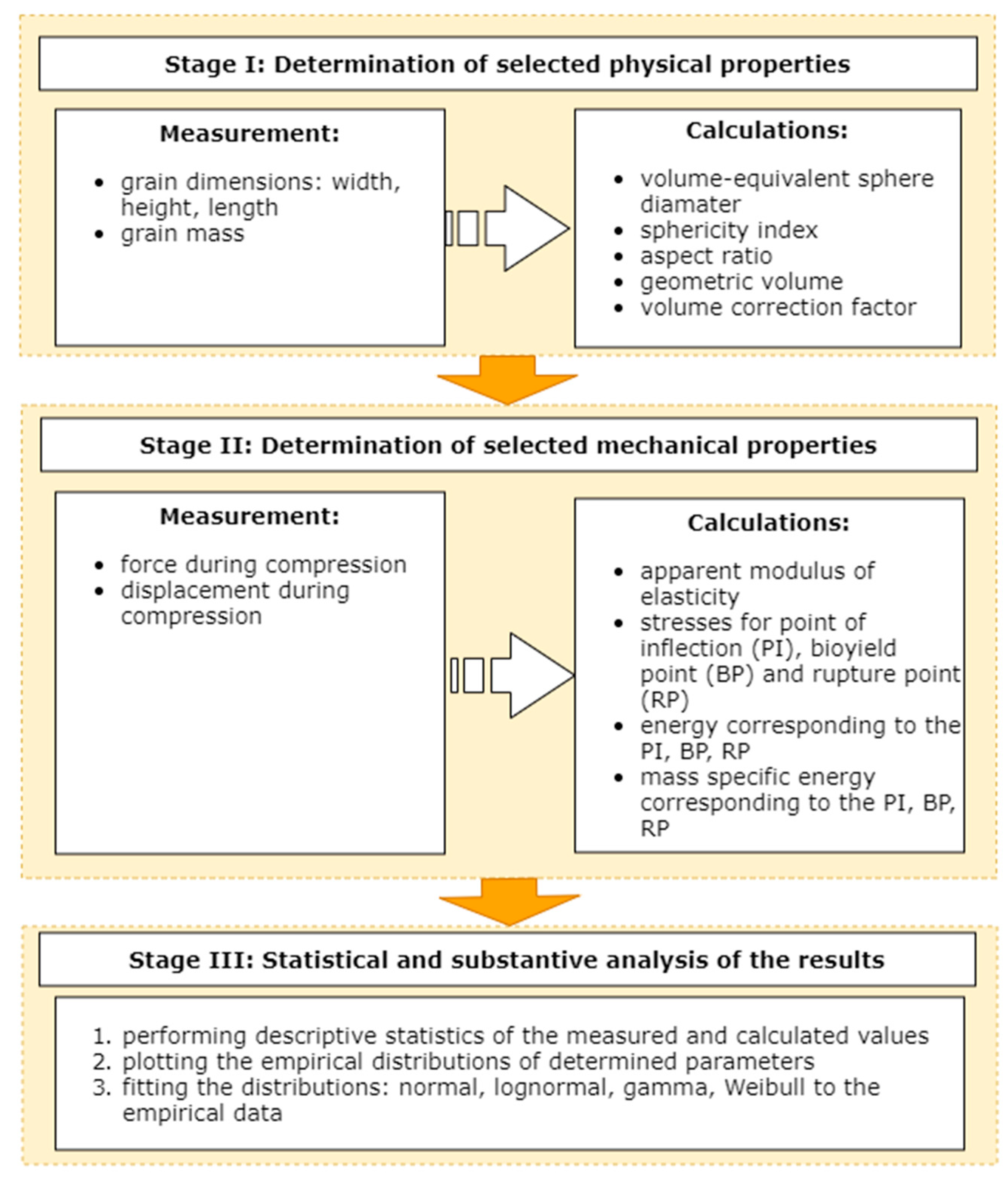
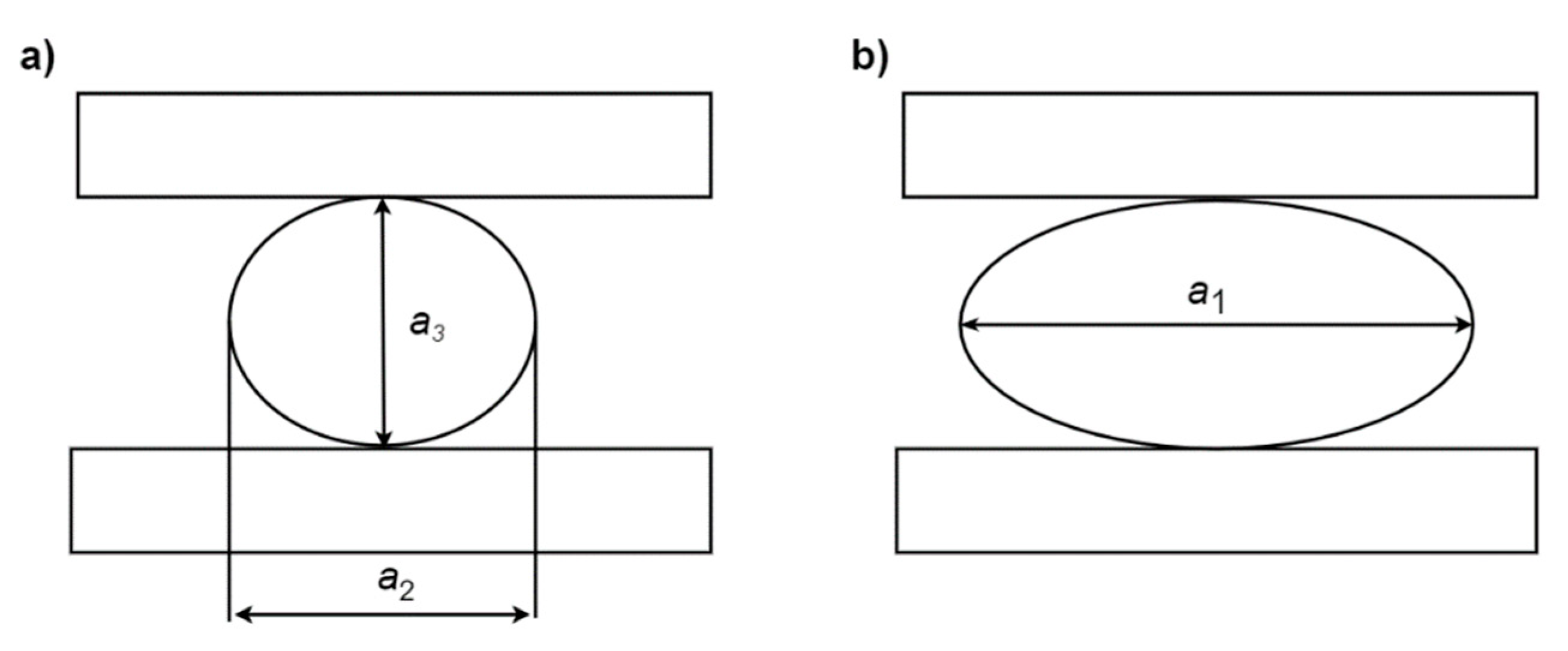
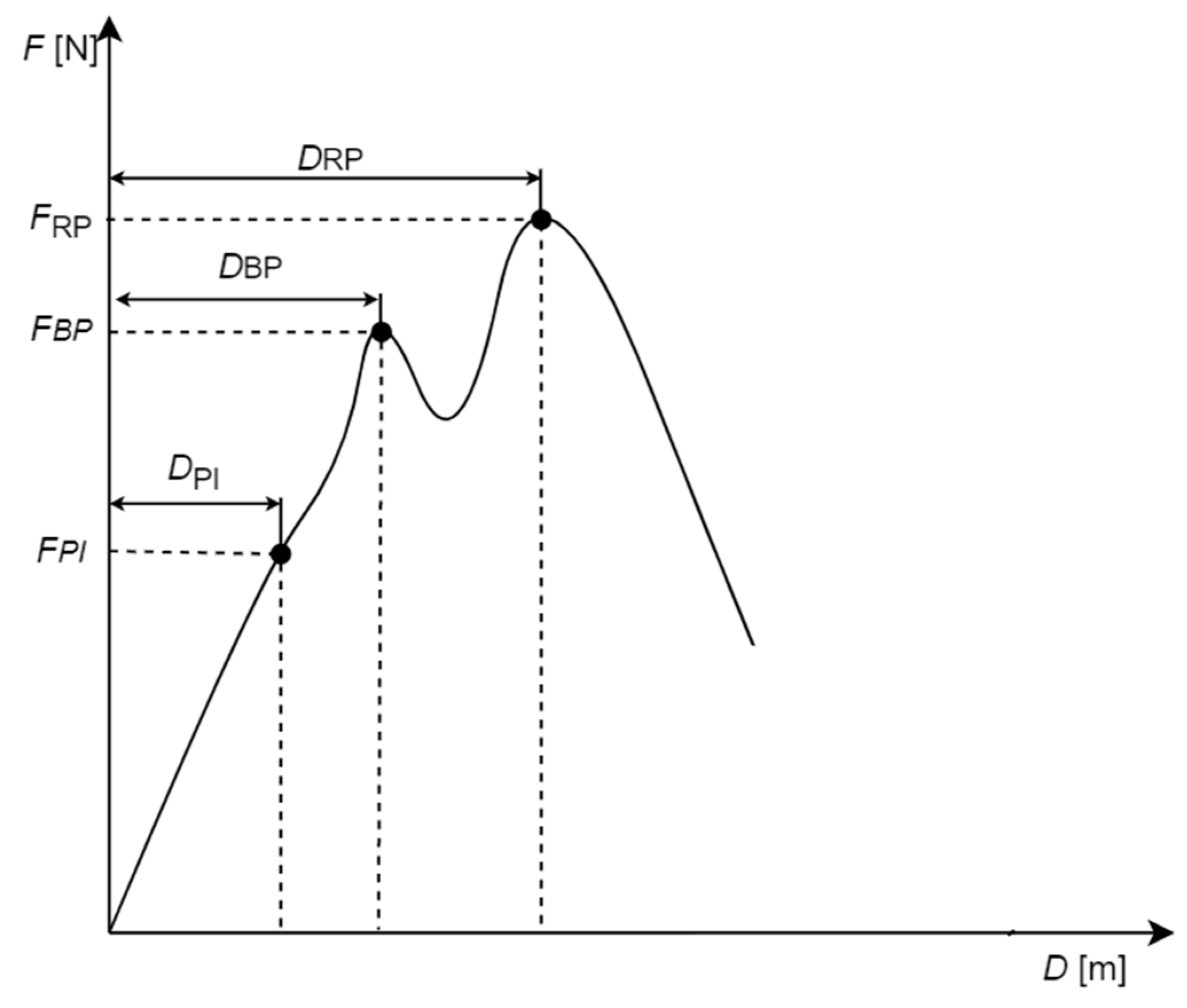
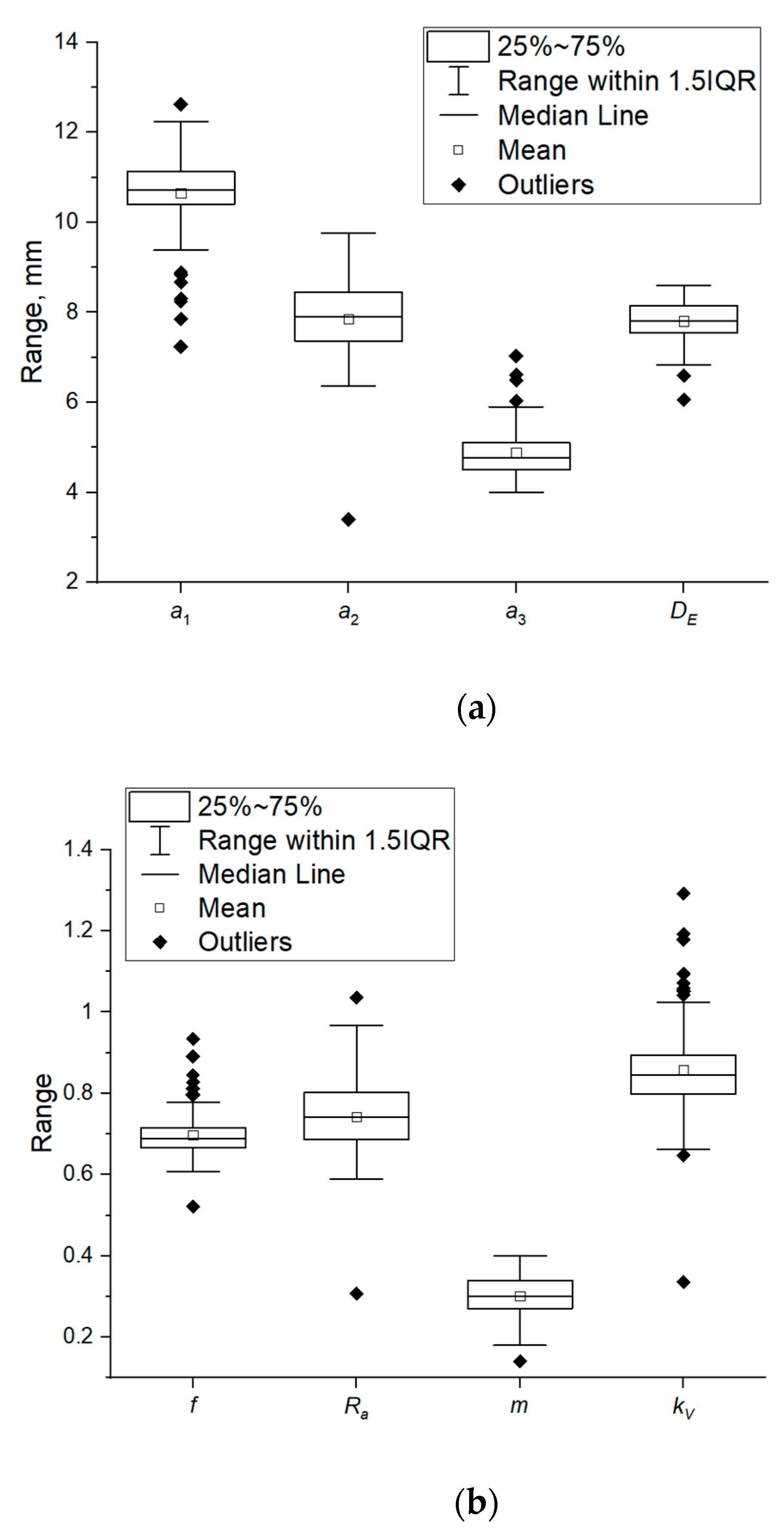
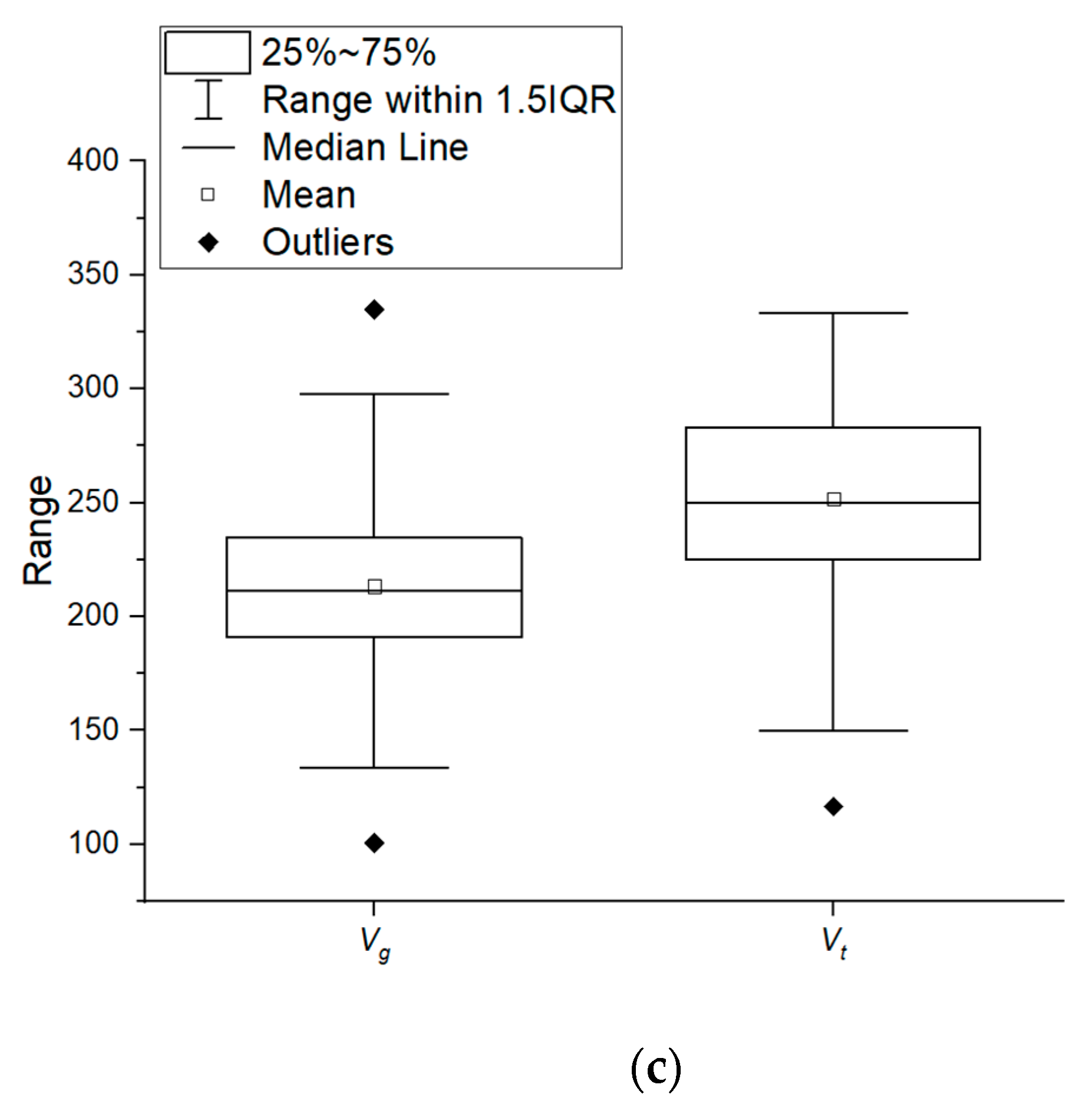
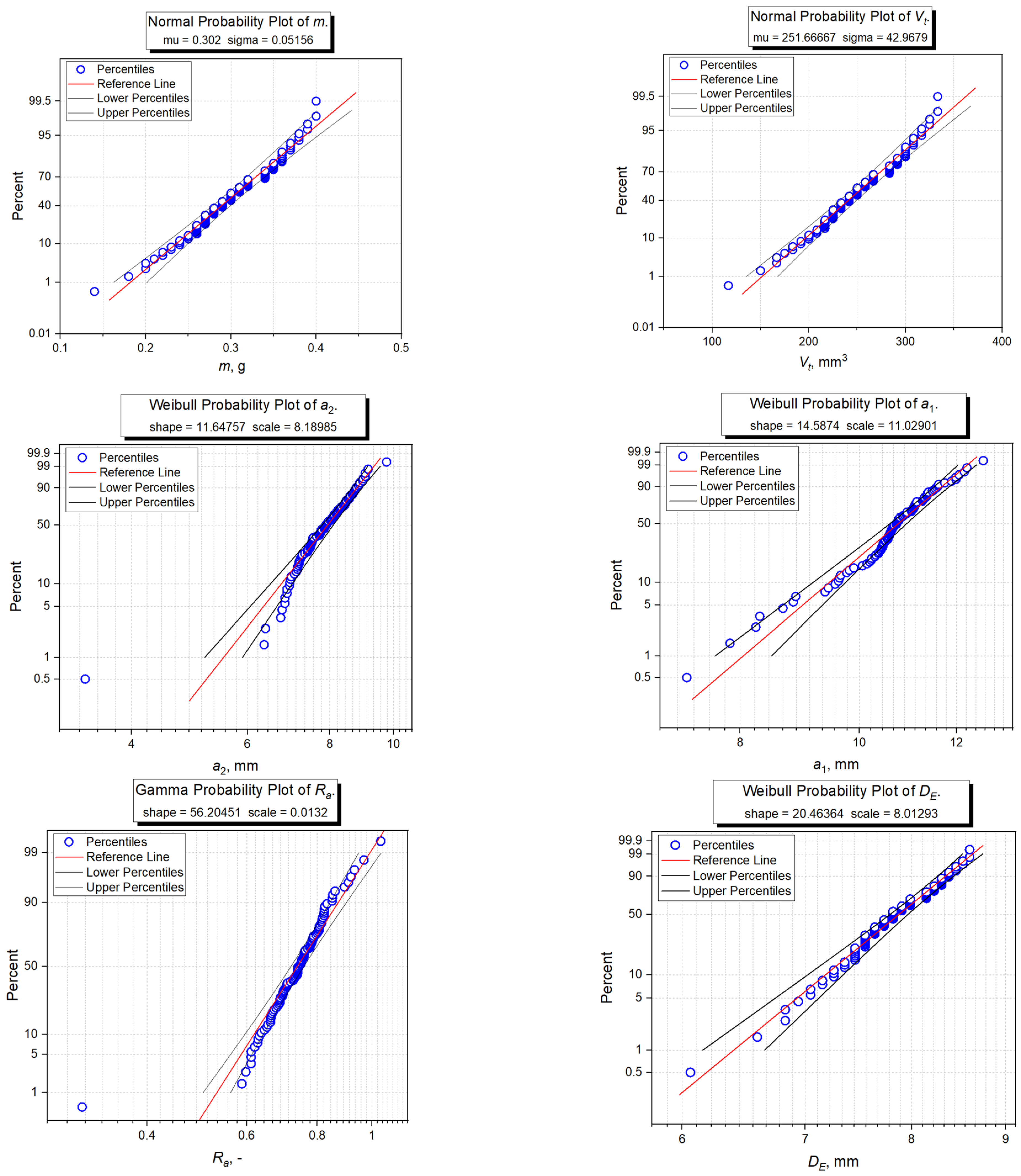
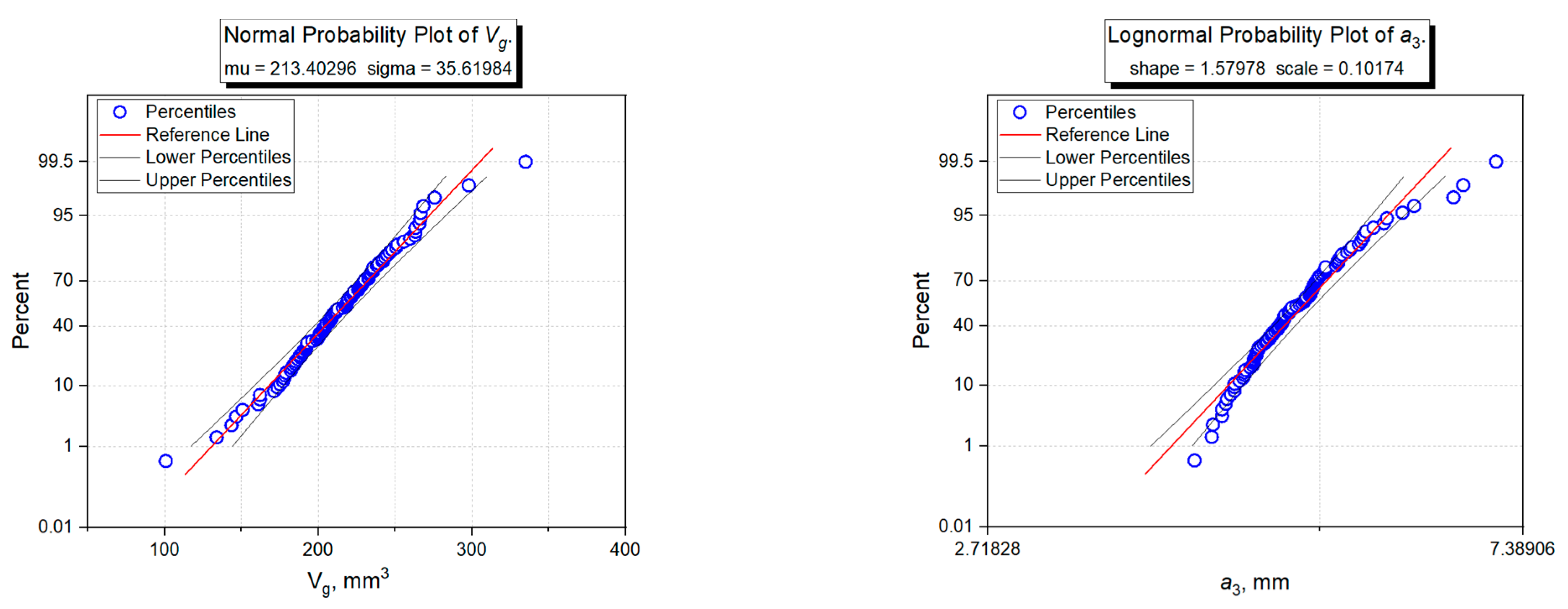
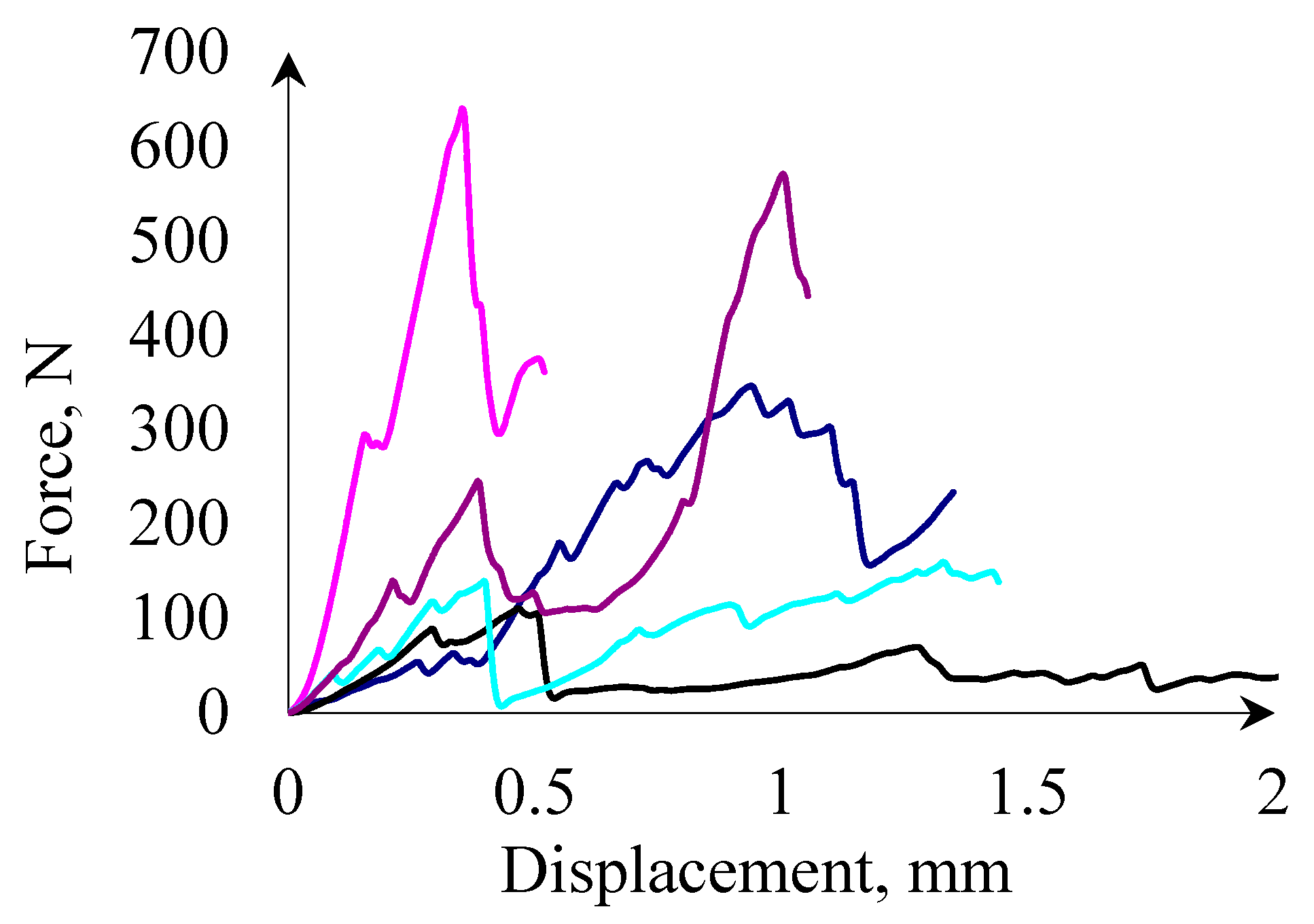
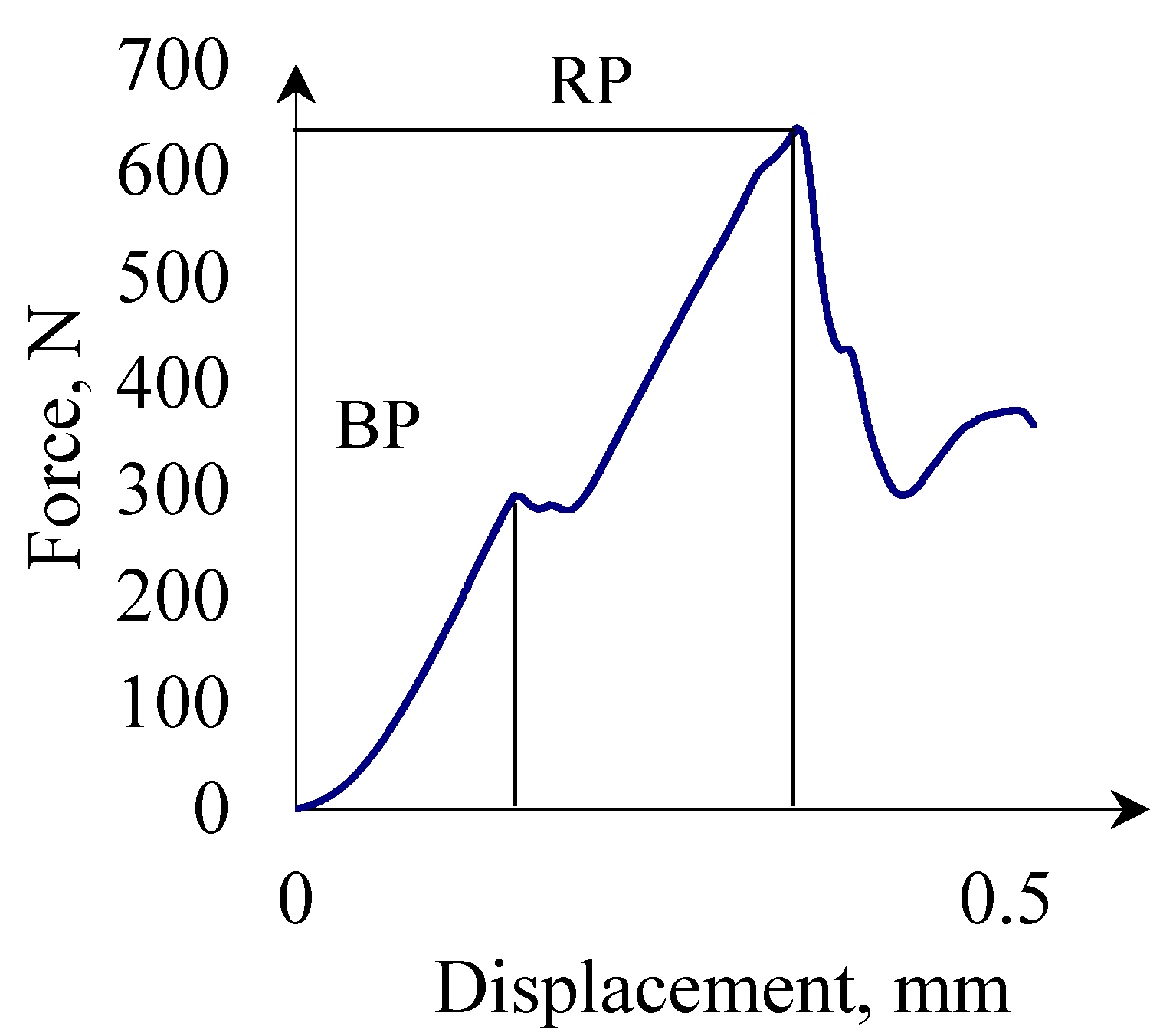
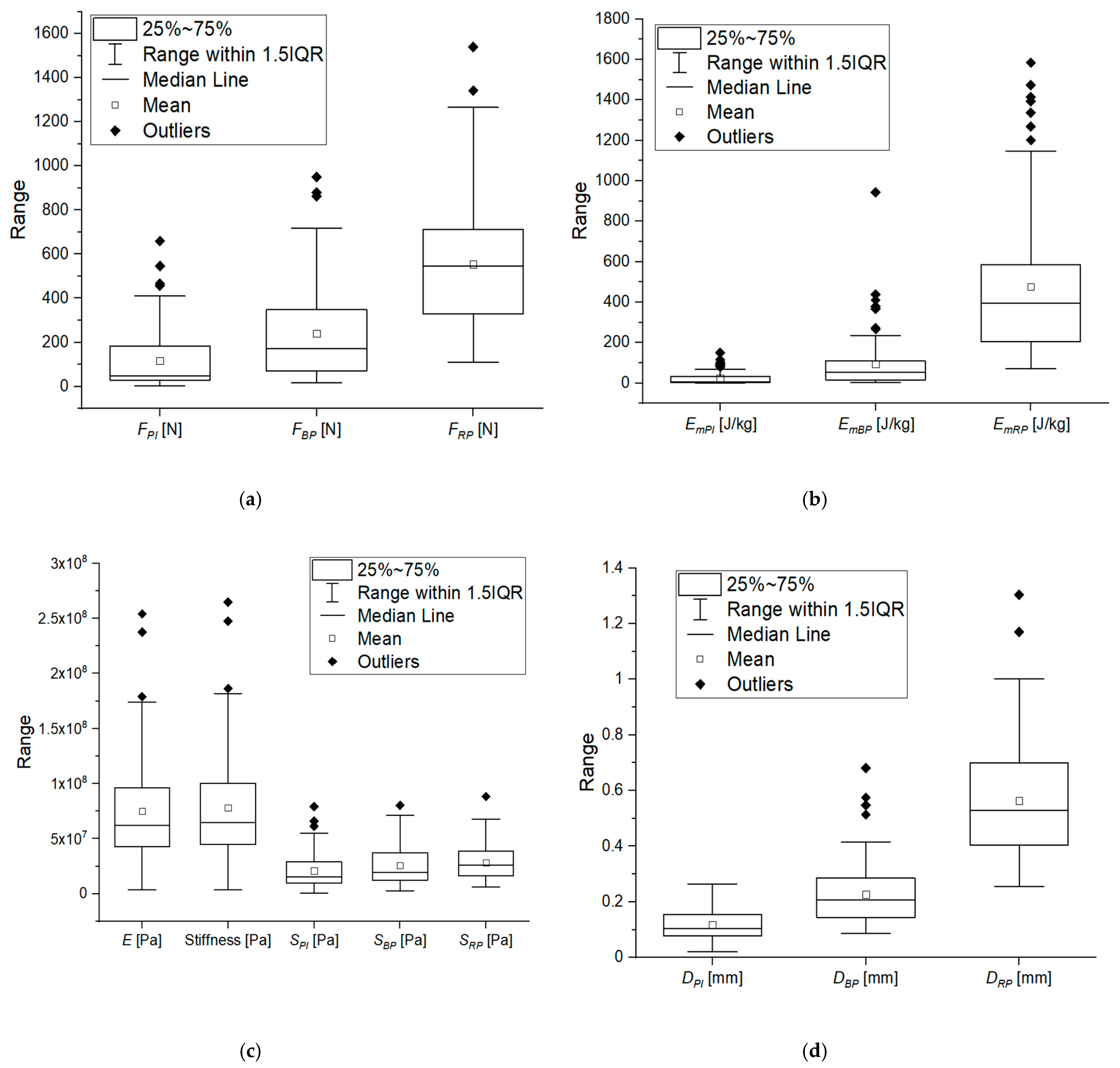
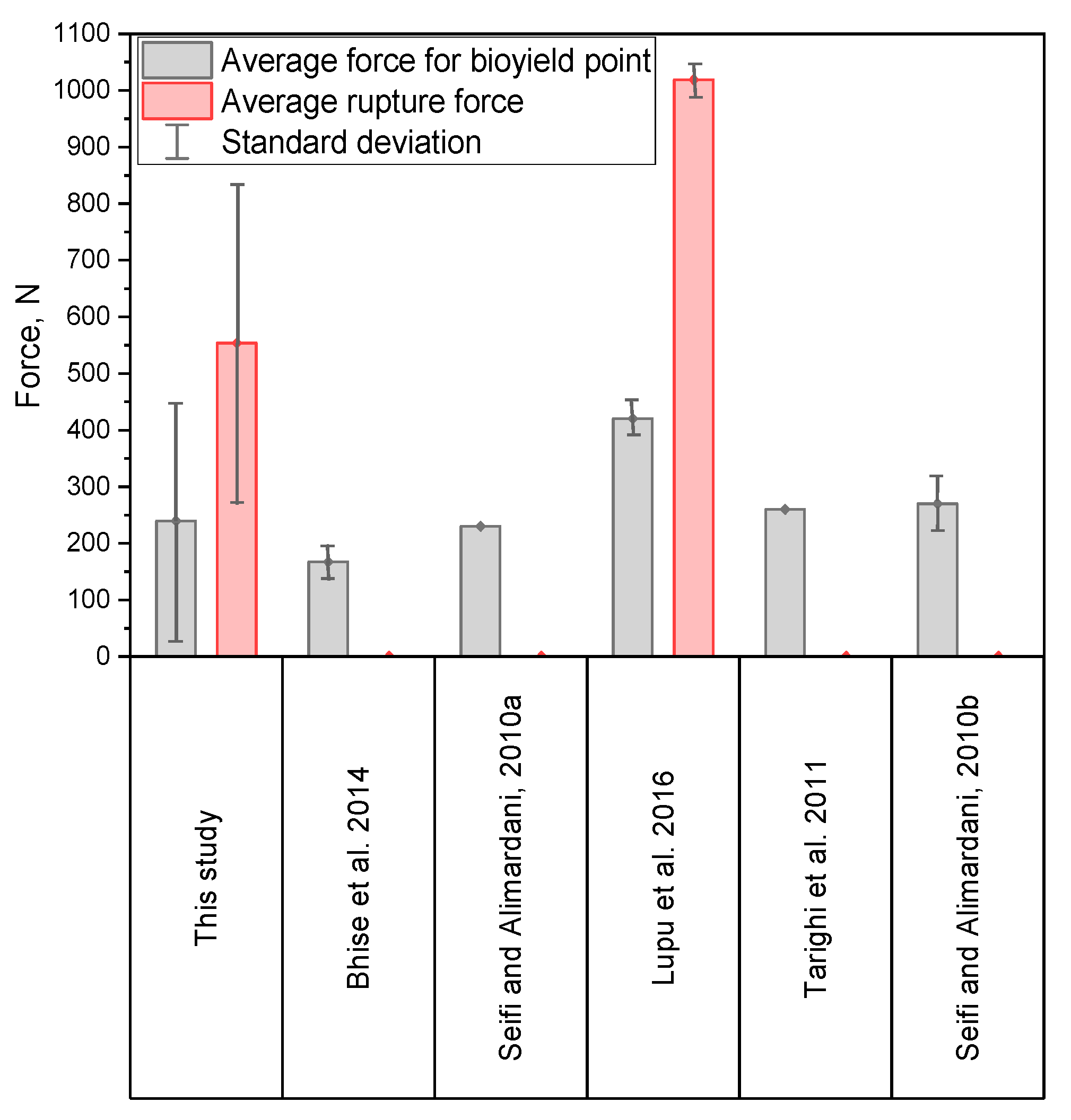
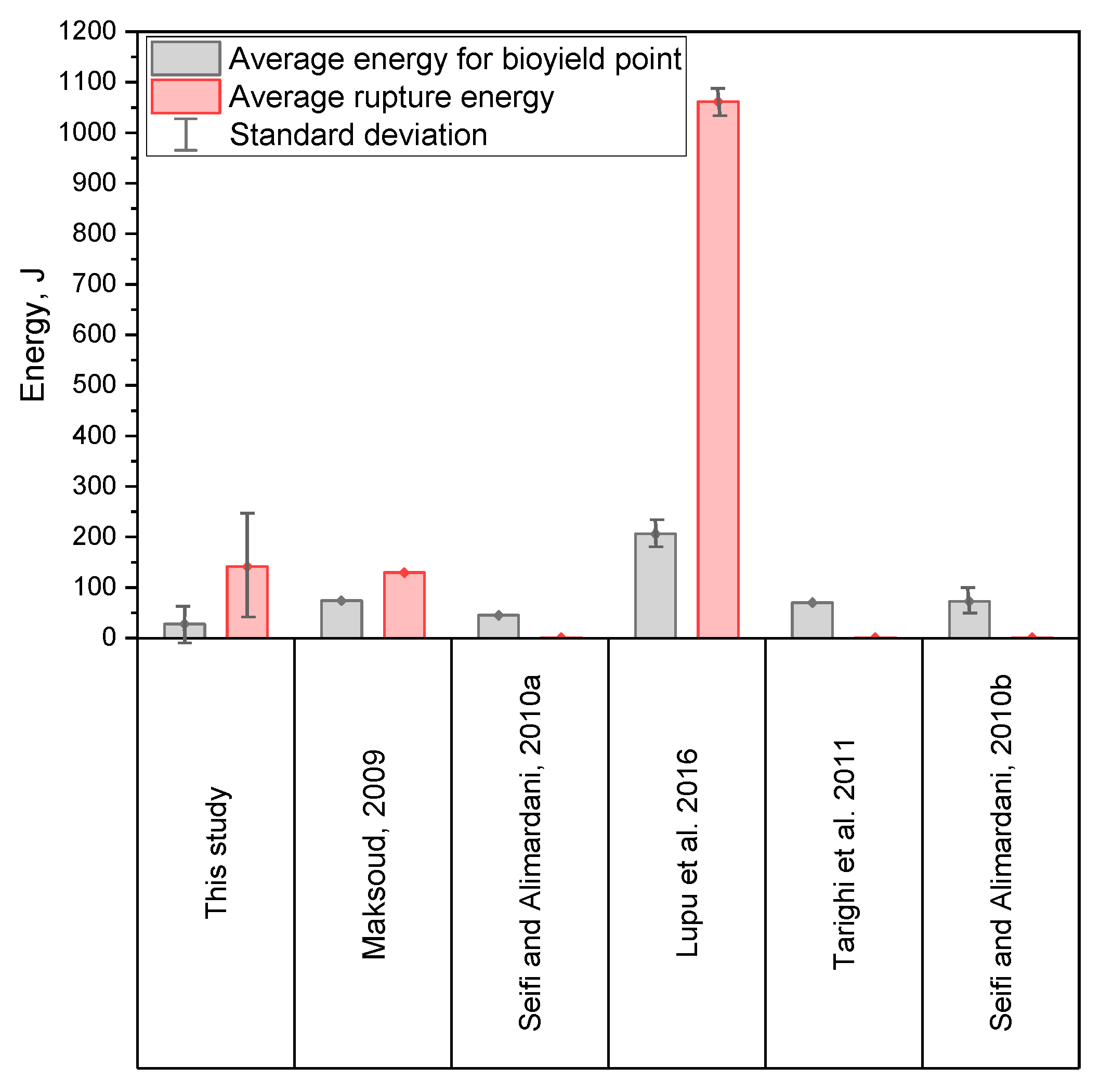
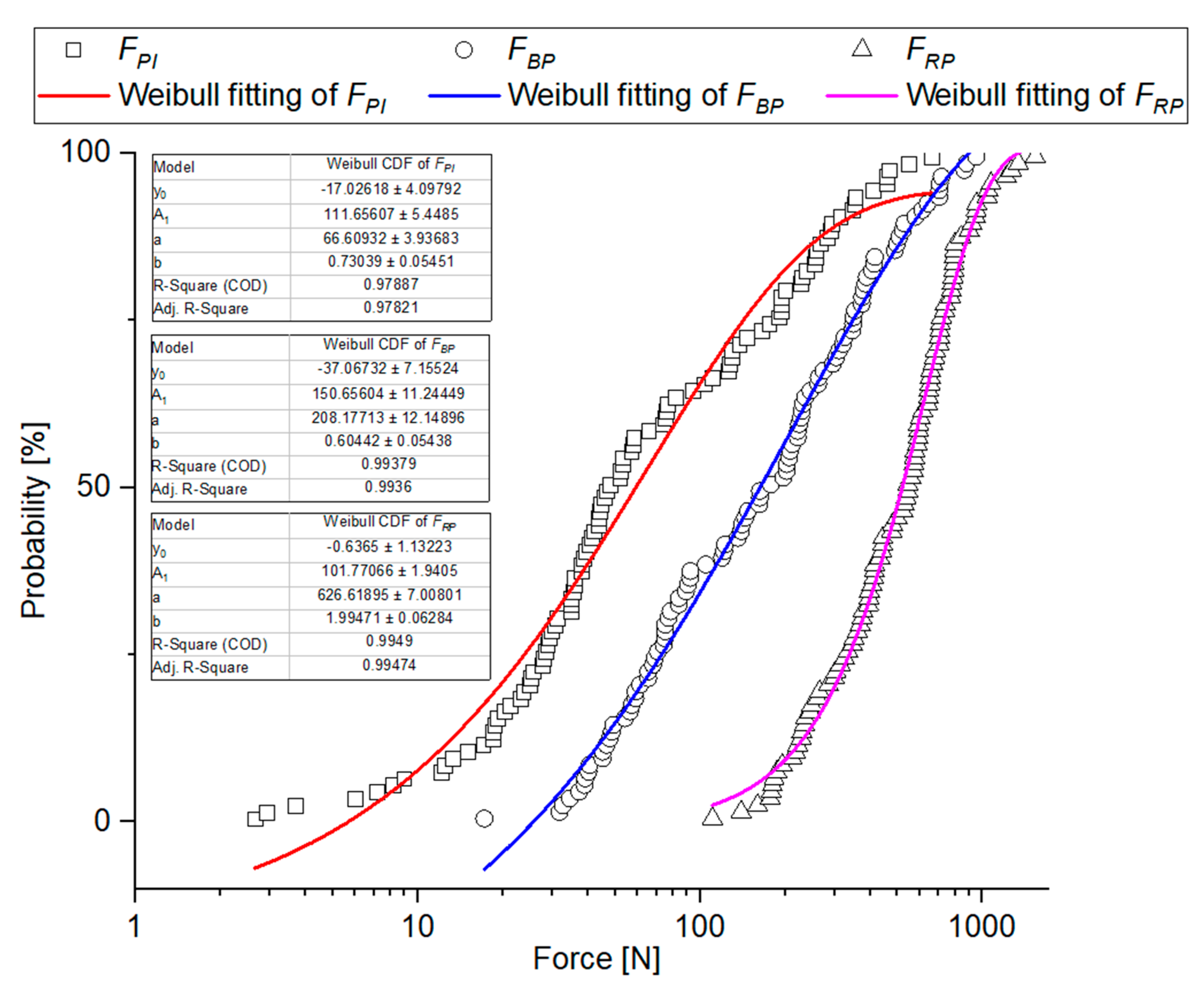
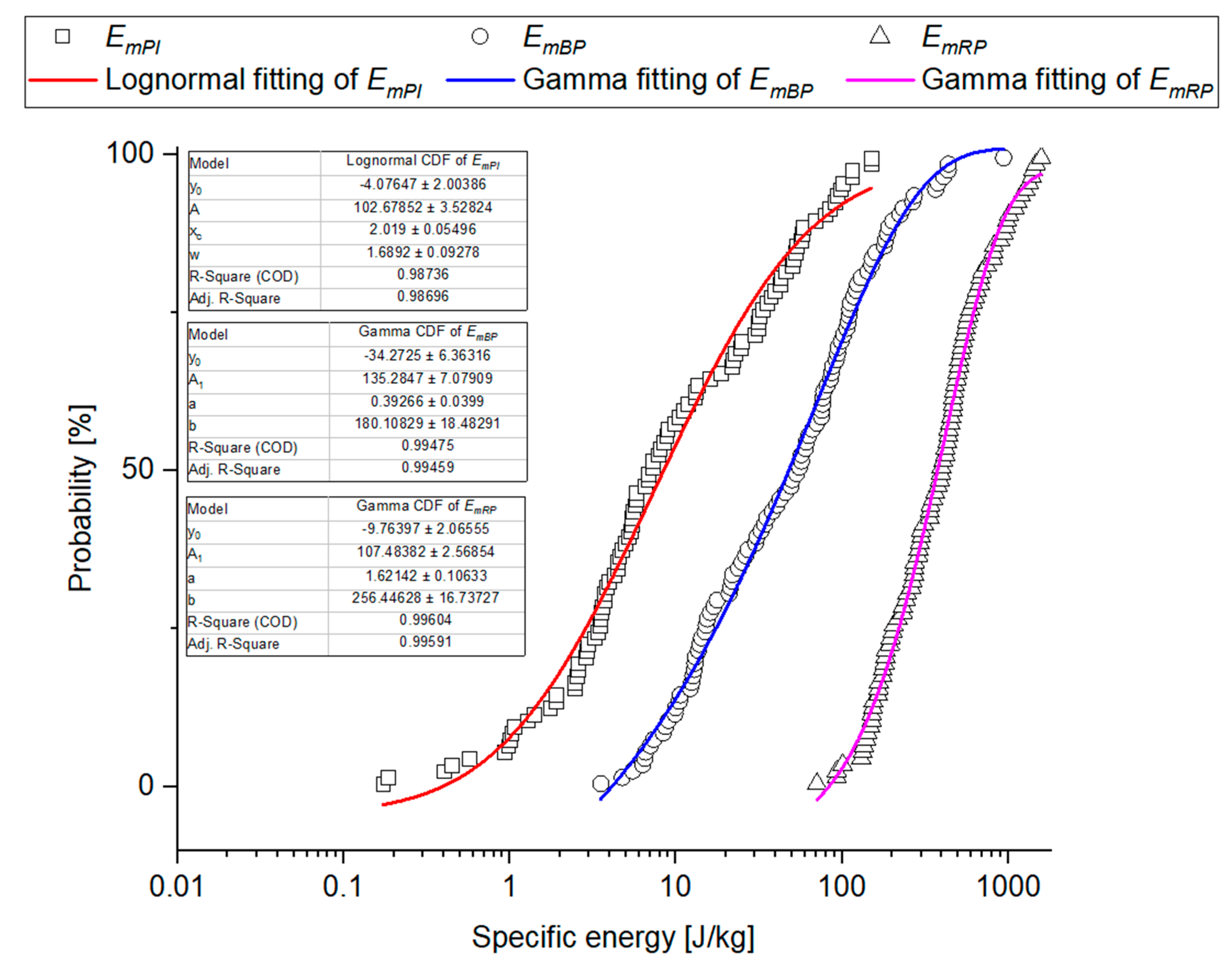

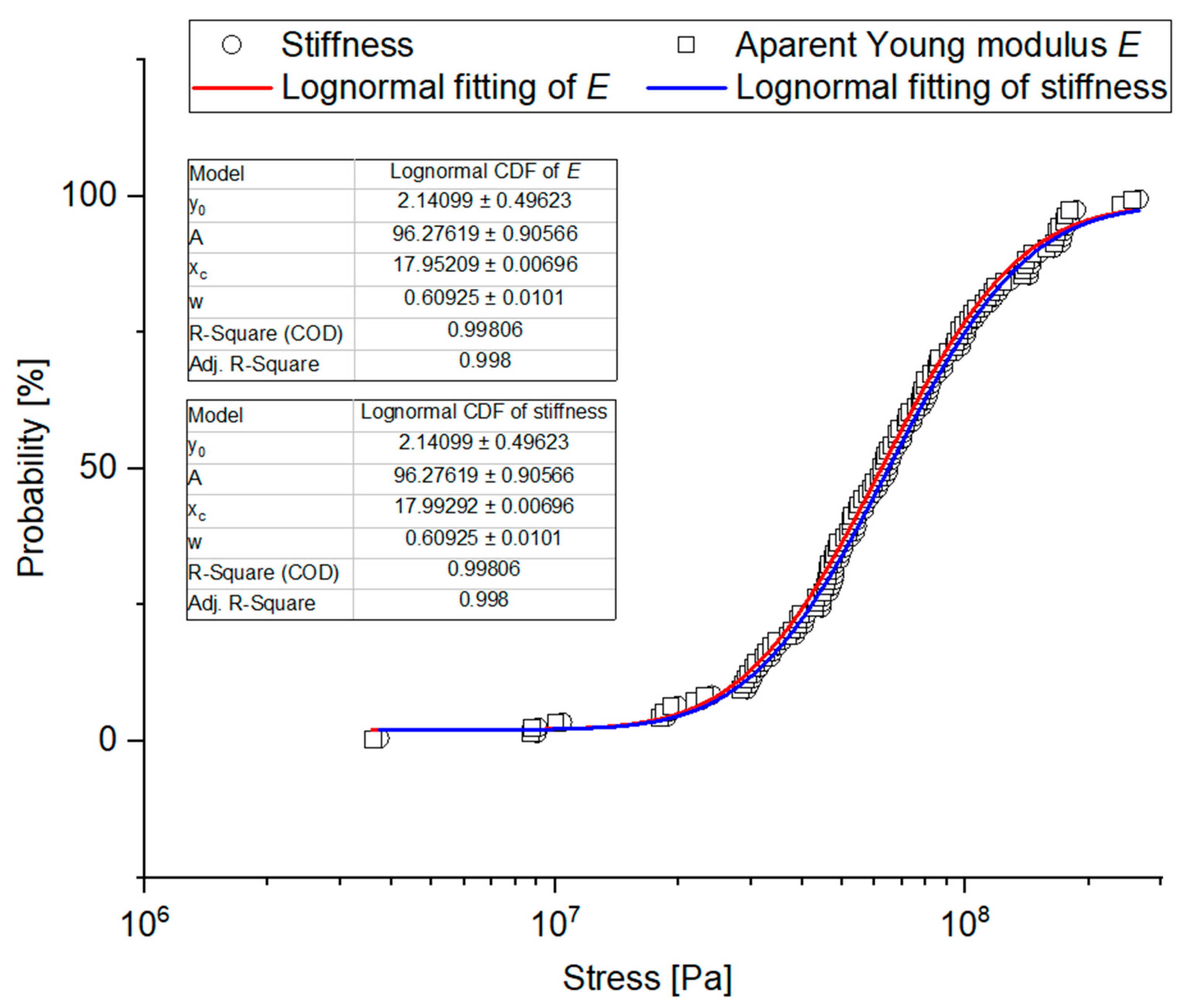
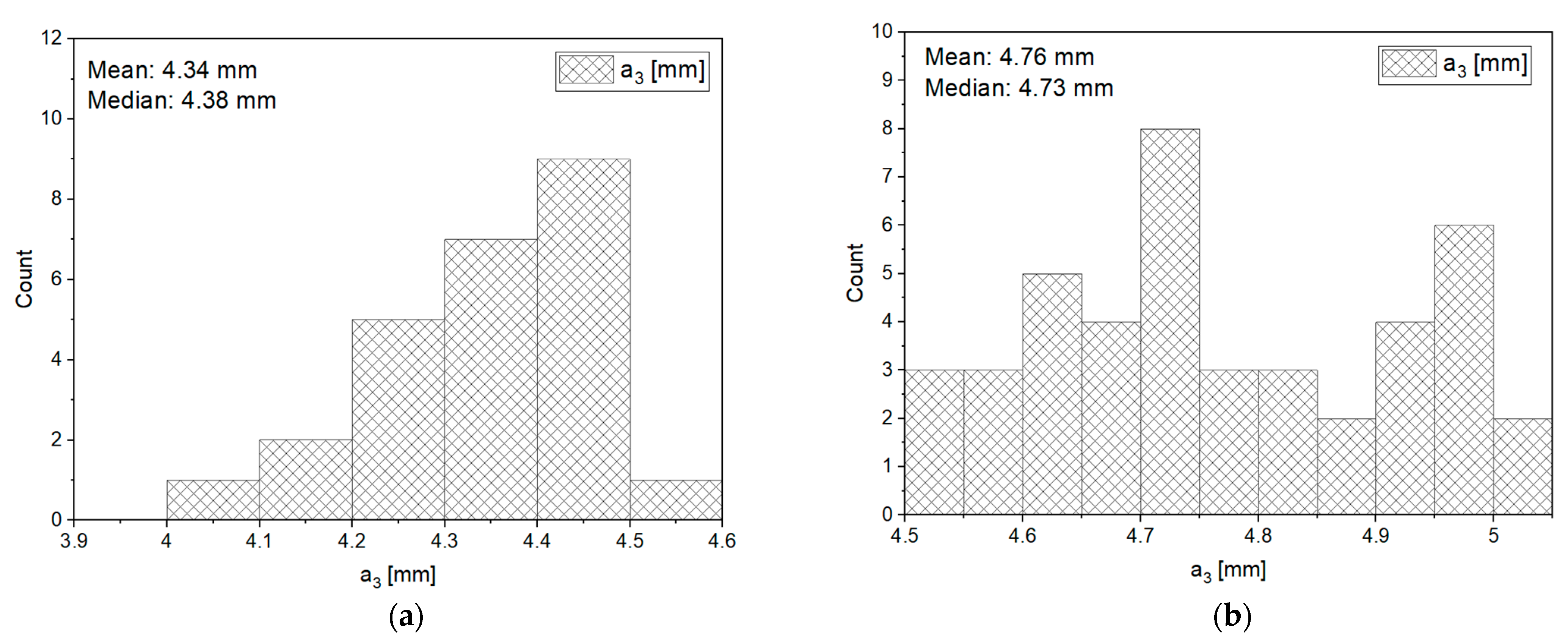



| Distribution | Mathematical Model | |
|---|---|---|
| Normal | (18) | |
| Lognormal | (19) | |
| Weibull | (20) | |
| Gamma | (21) | |
| Cumulative Distribution Function | Mathematical Model | |
|---|---|---|
| Lognormal | (23) | |
| Gamma | (24) | |
| Weibull | (25) | |
| Parameter | a1 [mm] | a2 [mm] | a3 [mm] | f [–] | Ra [–] | m [g] | Vg [mm3] | Vt [mm3] | kV [–] | DE [mm] |
|---|---|---|---|---|---|---|---|---|---|---|
| Average | 10.65 | 7.85 | 4.88 | 0.698 | 0.742 | 0.302 | 213.40 | 251.67 | 0.858 | 7.806 |
| Median | 10.72 | 7.90 | 4.78 | 0.689 | 0.742 | 0.300 | 211.54 | 250.00 | 0.845 | 7.816 |
| Standard deviation | 0.91 | 0.82 | 0.52 | 0.057 | 0.094 | 0.052 | 35.62 | 42.97 | 0.123 | 0.465 |
| Skewness | −1.15 | −1.50 | 1.44 | 1.267 | −0.510 | −0.332 | 0.08 | −0.33 | 0.230 | −0.746 |
| Kurtosis | 2.50 | 7.40 | 3.30 | 4.324 | 4.392 | 0.052 | 1.31 | 0.05 | 4.133 | 1.147 |
| Minimum | 7.24 | 3.40 | 4.00 | 0.521 | 0.307 | 0.140 | 100.70 | 116.67 | 0.336 | 6.062 |
| Maximum | 12.62 | 9.76 | 7.03 | 0.934 | 1.036 | 0.400 | 335.01 | 333.33 | 1.292 | 8.603 |
| Range | 5.38 | 6.36 | 3.03 | 0.413 | 0.729 | 0.260 | 234.31 | 216.67 | 0.956 | 2.540 |
| Coefficient of variation | 8.53 | 10.48 | 10.75 | 8.125 | 12.626 | 17.073 | 16.69 | 17.07 | 14.384 | 5.957 |
| Property | Shapiro-Wilk Test | Kolmogorov-Smirnov Modified Test | ||||||
|---|---|---|---|---|---|---|---|---|
| Normal | Lognormal | Weibull | Gamma | |||||
| Statistic | p-Value | Statistic | p-Value | Statistic | p-Value | Statistic | p-Value | |
| a1 [mm] | 0.92149 | 1.68911 × 10−5 | 0.16195 | ≤0.01 | 0.0944 | >0.1 | 0.15401 | ≤0.005 |
| a2 [mm] | 0.90576 | 2.66544 × 10−6 | 0.08903 | 0.0495 | 0.05821 | >0.1 | 0.07293 | >0.25 |
| a3 [mm] | 0.90579 | 2.67481 × 10−6 | 0.08664 | 0.06452 | 0.15801 | 0.02197 | 0.09354 | 0.0459 |
| f [–] | 0.88855 | 4.24999 × 10−7 | 0.12545 | ≤0.01 | 0.18801 | ≤0.01 | 0.13035 | ≤0.005 |
| Ra [–] | 0.94218 | 2.62455 × 10−4 | 0.09527 | 0.03379 | 0.09752 | >0.1 | 0.08562 | 0.09943 |
| m [g] | 0.98115 | 0.16318 | - | - | - | - | - | - |
| Vg [mm3] | 0.98671 | 0.41869 | - | - | - | - | - | - |
| Vt [mm3] | 0.98115 | 0.16318 | - | - | - | - | - | - |
| kV [–] | 0.91001 | 4.31216 × 10−6 | 0.12653 | ≤0.01 | 0.17343 | ≤0.01 | 0.12976 | ≤0.005 |
| DE [mm] | 0.96098 | 0.00472 | 0.07756 | 0.14271 | 0.08834 | >0.1 | 0.07943 | 0.15827 |
| Parameter | FPI [N] | FBP [N] | FRP [N] | DPI [mm] | DBP [mm] | DRP [mm] | EmPI [J/kg] | EmBP [J/kg] | EmRP [J/kg] | SPI [Pa] | SBP [Pa] | SRP [Pa] | E [Pa] | Stiffness [Pa] |
|---|---|---|---|---|---|---|---|---|---|---|---|---|---|---|
| Mean | 115.96 | 239.75 | 553.80 | 0.119 | 0.227 | 0.564 | 23.77 | 92.65 | 477.10 | 2.11 × 107 | 2.60 × 107 | 2.83 × 107 | 7.50 × 107 | 7.81 × 107 |
| Standard Deviation | 135.81 | 215.63 | 286.71 | 0.061 | 0.108 | 0.204 | 33.45 | 129.75 | 349.79 | 1.68 × 107 | 1.76 × 107 | 1.57 × 107 | 4.93 × 107 | 5.13 × 107 |
| Skewness | 1.77 | 1.36 | 0.83 | 0.777 | 1.512 | 0.925 | 2.01 | 3.65 | 1.37 | 1.29 | 0.98 | 0.94 | 1.29 | 1.29 |
| Kurtosis | 2.94 | 1.37 | 0.82 | −0.262 | 3.445 | 0.990 | 3.77 | 18.80 | 1.36 | 1.04 | 0.15 | 0.98 | 1.75 | 1.75 |
| Coefficient of Variation | 1.17 | 0.90 | 0.52 | 0.513 | 0.477 | 0.361 | 1.41 | 1.40 | 0.73 | 0.80 | 0.68 | 0.56 | 0.66 | 0.66 |
| Minimum | 2.65 | 17.23 | 110.74 | 0.020 | 0.087 | 0.256 | 0.17 | 3.53 | 70.70 | 8.52 × 105 | 2.94 × 106 | 6.12 × 106 | 3.59 × 106 | 3.74 × 106 |
| Median | 47.38 | 170.84 | 544.74 | 0.104 | 0.208 | 0.530 | 7.03 | 54.46 | 396.43 | 1.52 × 107 | 1.93 × 107 | 2.62 × 107 | 6.22 × 107 | 6.48 × 107 |
| Maximum | 659.84 | 950.20 | 1539.94 | 0.265 | 0.681 | 1.304 | 150.48 | 942.91 | 1583.78 | 7.93 × 107 | 8.04 × 107 | 8.84 × 107 | 2.54 × 108 | 2.65 × 108 |
| Range | 657.19 | 932.97 | 1429.20 | 0.245 | 0.594 | 1.048 | 150.30 | 939.38 | 1513.08 | 7.84 × 107 | 7.75 × 107 | 8.23 × 107 | 2.50 × 108 | 2.61 × 108 |
| Property | Shapiro-Wilk Test | Kolmogorov-Smirnov Modified Test | ||||||
|---|---|---|---|---|---|---|---|---|
| Normal | Lognormal | Weibull | Gamma | |||||
| Statistic | p-Value | Statistic | p-Value | Statistic | p-Value | Statistic | p-Value | |
| FPI [N] | 0.75967 | 1.69986 × 10−11 | 0.08888 | 0.04987 | 0.14577 | 0.05921 | 0.16277 | ≤0.005 |
| FBP [N] | 0.84484 | 7.67875 × 10−9 | 0.09377 | 0.03757 | 0.11384 | >0.1 | 0.12207 | ≤0.005 |
| FRP [N] | 0.94883 | 6.95722 × 10−4 | 0.09072 | 0.04526 | 0.06169 | >0.1 | 0.06076 | >0.25 |
| EmPI [J/kg] | 0.67974 | 1.86462 × 10−13 | 0.07698 | 0.14929 | 0.12495 | >0.1 | 0.15474 | ≤0.005 |
| EmBP [J/kg] | 0.62964 | 1.63203 × 10−14 | 0.08057 | 0.10824 | 0.06883 | >0.1 | 0.08864 | 0.07781 |
| EmRP [J/kg] | 0.85688 | 2.14812 × 10−8 | 0.05841 | >0.15 | 0.07434 | >0.1 | 0.06492 | >0.25 |
| SPI [Pa] | 0.85758 | 2.28423 × 10−8 | 0.06069 | >0.15 | 0.12295 | >0.1 | 0.1123 | 0.0053 |
| SBP [Pa] | 0.89738 | 1.0673 × 10−6 | 0.0735 | >0.15 | 0.12692 | >0.1 | 0.11189 | 0.00563 |
| SRP [Pa] | 0.9313 | 5.90074 × 10−5 | 0.05331 | >0.15 | 0.07236 | >0.1 | 0.05269 | >0.25 |
| E [Pa] | 0.89642 | 9.63659 × 10−7 | 0.07299 | >0.15 | 0.07262 | >0.1 | 0.05103 | >0.25 |
| Stiffness [Pa] | 0.89642 | 9.63659 × 10−7 | 0.07299 | >0.15 | 0.07262 | >0.1 | 0.05103 | >0.25 |
| Median FPI | Median FBP | Median FRP | Median EmPI | Median EmBP | Median EmRP | Median SPI | Median SBP | Median SRP | ||
|---|---|---|---|---|---|---|---|---|---|---|
| Average a3 | r-Pearson’s | −0.86507 | −0.70918 | −0.99289 * | −0.87089 | −0.66334 | −0.97821 * | −0.8959 | −0.87365 | −0.9926 * |
| p-Value | 0.13493 | 0.29082 | 0.00711 | 0.12911 | 0.33666 | 0.02179 | 0.1041 | 0.12635 | 0.0074 |
Publisher’s Note: MDPI stays neutral with regard to jurisdictional claims in published maps and institutional affiliations. |
© 2021 by the author. Licensee MDPI, Basel, Switzerland. This article is an open access article distributed under the terms and conditions of the Creative Commons Attribution (CC BY) license (http://creativecommons.org/licenses/by/4.0/).
Share and Cite
Kruszelnicka, W. Study of Selected Physical-Mechanical Properties of Corn Grains Important from the Point of View of Mechanical Processing Systems Designing. Materials 2021, 14, 1467. https://doi.org/10.3390/ma14061467
Kruszelnicka W. Study of Selected Physical-Mechanical Properties of Corn Grains Important from the Point of View of Mechanical Processing Systems Designing. Materials. 2021; 14(6):1467. https://doi.org/10.3390/ma14061467
Chicago/Turabian StyleKruszelnicka, Weronika. 2021. "Study of Selected Physical-Mechanical Properties of Corn Grains Important from the Point of View of Mechanical Processing Systems Designing" Materials 14, no. 6: 1467. https://doi.org/10.3390/ma14061467
APA StyleKruszelnicka, W. (2021). Study of Selected Physical-Mechanical Properties of Corn Grains Important from the Point of View of Mechanical Processing Systems Designing. Materials, 14(6), 1467. https://doi.org/10.3390/ma14061467






